












Join thousands of students and teachers across Aotearoa and around the world using Music Ecademy to improve musical literacy.
Developed in Aotearoa New Zealand. Curriculum following the major music exam boards, school curriculum including NCEA and musical terms in Te Reo Māori.
Teacher accounts allow you to track your students' progress. With individual logins for each student, Music Ecademy is perfect for BYOD.

Leaderboards, levels and badges help to keep students engaged. Thousands of possible questions in hundreds of quizzes help students learn the best way possible – through practice!
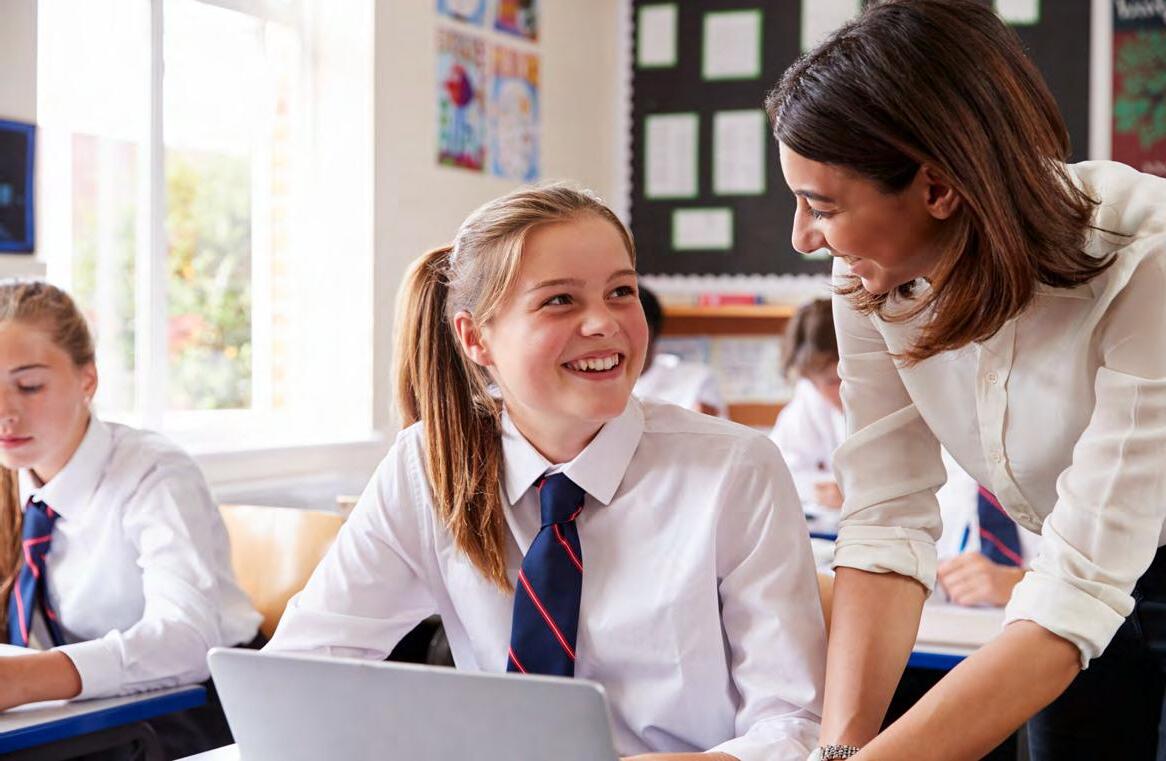
Ben Lau (Chair) - Wellington blau@newlands.school.nz
Katrina Daniela (Deputy Chair) - Tauranga kdaniela@papamoacollege.school.nz
Megan Flint (Secretary) - Taupo meganjude@xtra.co.nz
Charlotte Nicklin (Treasurer) - Auckland C.Nicklin@maristcollege.school.nz
Jade Browne - Hamilton jadebrowne@outlook.co.nz
Hayley Hunter - Auckland hayley@xanadu.co.nz
Anne-Marie Lalakai - Auckland anne-mariel@wesley.school.nz
Christian McDonald - Northland christianm@taipa.school.nz
Chris Williamson - Tauranga c.williamson@tbc.school.nz
Chair of MENZA Network of Expertise Committee
Christian McDonald christianm@taipa.school.nz
MENZA ISME National Affiliate Representative
Linda Webb lgwgwebb@gmail.com
For advertising enquiries, contact Pauline Logger: admin@menza.co.nz
Editor: Duncan Ferguson duncan@learningideas.co.nz
Design and Printing:
McEwan&Co.org & RazzPrint.co.nz
TUNE ME IN is published by:
MENZA: Music Education New Zealand Aotearoa. The professional magazine for all New Zealand music educators.


MENZA Vision: Together Growing Musical Lives.

MENZA Website: menza.co.nz
The postal address is: MENZA, c/- 1288 Upper Ohauiti Road, RD3, Tauranga 3173
The Editorial team encourages reader feedback. If you have any comments or experiences that relate to articles published in Tune Me In, please mail or email them to Pauline Logger, the MENZA Administrator at admin@menza.co.nz
These may be printed in the next edition of the magazine or published on the MENZA website. The views expressed do not necessarily reflect the views of the MENZA Board and the Tune Me In Editorial team.
The Editorial team request that sources are rightfully acknowledged in all MENZA publications. Where it is felt a breach of this protocol may have occurred this can be notified to the editor or directly to the writer. MENZA has an expectation of ethical practices in the matter of disclosures.
ISSN 2381-9987 (Print) ISSN 2381-9995 (Online)
Puawaiata
32 TAI OROORO TAI AUAHA
- Priya Gain
38 POLYFEST REPORT
- Anne-Marie Lalakai & Dr Opeloge Ah Sam
42 TURNING AN UNLIKELY COMBINATION OF DIVERSE INSTRUMENTS INTO A PERFORMANCE GROUP


- Judith Bell
45 THE TOOL OF A MUSICAL MIND
- Rachel Young
46 DOUG KELLY OBITUARY
Tips for Music
Directing a musical DUNCAN FERGUSON
2023 has started with a hiss and a roar for MENZA. Over a weekend in February, we met as a board to continue discussions regarding our strategic goals. We have created a draft strategic plan for the MENZA board and are excited to have a clearer path moving forward to focus on the areas that fall under the MENZA umbrella. Also, over that weekend, we held an SGM (Special General Meeting), and we presented a new constitution to our membership. It will go out for consultation again, and at our Annual General Meeting in June we will ask the membership to approve the final version.
In March, a working group of secondary school teachers and tangata whenua met in Whanganui-a-Tara. The purpose of the hui was to begin the process of developing a plan on how MENZA can assist secondary school music teachers with the NCEA change package and with the new Level 1 Music standards being used next year. The change package brings a different way of thinking for our students, more inclusivity, a change in how we assess our students and more of a focus towards mātauranga Māori and learning.
We will be holding hui regarding mātauranga pūoru Māori in several areas around the motu. We have made a conscious decision not to currently release resources but hold face-to -face hui to allow music teachers in the secondary sector to build relationships with other teachers in the sector and with mana whenua. It is an exciting time, but we are also aware of how teachers in the secondary sector are anxious about implementing the change next year.
With Networks of Expertise funding, we are excited to release new resources for teachers in the early childhood and primary education sectors. A lot of thought and time has been put into these resources, and we cannot wait to share them with our membership. We will be holding workshops and zoom sessions for teachers to attend. Keep an eye on our Facebook page or your inbox for future dates and details.
In other board news, sadly, Makaira Waugh is stepping down after two and a half years. Initially he started as a co-opted member and was elected as a full board member in June 2022. As tangata whenua and with his experience in Kura Kaupapa and Te Ao Māori, Makaira brought a much -needed perspective to the board. We wish him well in his future endeavours.

Finally, the MENZA conference is coming up in October 2023 in Tauranga. I am so excited for it to be happening after so many postponements. Katrina Daniela and her Tauranga-based working group are organising what looks like an awesome conference. Keep an eye out for further details.
Ben Lau ChairpersonHe waka eke noa Kia ngatahi te hoe, kia whakatere te waka ki uta!
Jump on the waka and navigate towards success for all
2023 has, like most other years recently, provided many challenges for teachers and students. The cyclones, floods and other natural disasters have made the start of this year terrible for many kura. How do kids learn when they don’t feel safe? When they’re displaced from their home?
For those of us that suffered through the Christchurch Earthquakes we are seeing many parallels to what many are now having to deal with in the North Island. As I think back 10+ years to what we dealt with in Christchurch, while I remember some really hard parts, I also remember the amazing sense of community, sharing and aroha that became the norm for so many of us in our school environments.
What helped so many of our ākonga heal during that time was the routine of classes (once school opened again), the enjoyment of rehearsals, and the joy of putting on a production and other musical performances.

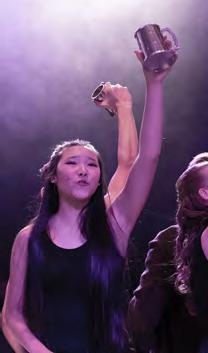

It’s why I sat and read the article from Michelle Wilson with tears in my eyes as she writes about the healing power of music page 8. It also impresses on me once again the amazing privilege it is to be a music teacher. As she talks about the scientific basis for the healing power of singing, I am reminded that once again it’s great to be a music teacher. I imagine it’s hard for a secondary maths teacher to be able to start classes with singing, but in a music classroom it’s normal and in many places, expected.
Singing and playing instruments is exactly what so many students that are suffering from the trauma of 2023 (on top of what they went through in COVID-affected 2020-2022) need right now. While the government and local communities are providing for the physical needs of everyone, it’s the creative people that can help with bringing joy and mental relief in the midst of suffering.
Ngā mihi, Duncan Ferguson Editor
In the early days, we were unaware of the ongoing impact that trauma would have upon our children. Musical play became vital in helping children to grow resilience and heal. Healing qualities have been attributed to music for centuries and can facilitate post-traumatic growth. What a powerful and moving sight to see RSE workers singing together in the dark after their rescue from the roof during the Cyclone. Again and again, people turn to singing in the midst of disaster. After the earthquakes we sang familiar, soothing songs with children. During the Covid pandemic, Queenslander Astrid Jorgensen, realising people were isolated, morphing her Pub Choir into a Couch Choir online. It became a phenomenon as people sang together from 18 countries. Singing is accessible for everyone.
In Christchurch, we identified our training, rooted in behaviourism, was not helpful when working with traumatised children. Behaviour modification techniques and talking were not the answer as traumatic experiences were embedded beneath the language brain, in the amygdala and the body. We needed to expand our horizons. Music was already part of our tool-kit and with singing we didn’t need any equipment or power. We realised that all human beings were wired with a music part inside us which connected mind and body, grounded and healed us. As adults, looking after children and babies, we could be released from the burden of ‘getting it right’ for traumatised children. All we needed to do was provide the opportunity for musical play.
Rhythm stimulates patterned, repetitive neural brainstem activity necessary for the restoration of brain functioning (Rosenberg, Greenburg & Lamb, 2021).
Van Der Kolk (2007), writes in The Body Keeps the Score, that rhythmic activities can reawaken feelings of pleasure and engagement that are dulled by prolonged trauma exposure. Singing together regulates arousal, maintains alertness and allows for predictable cycles. In my daughter’s class at school they sang every morning. Her teacher explained the way in which singing helped to release endorphins; hormones that relieve pain, reduce stress and improve mood. The class laughed the next morning when a student asked if they could please, “release the dolphins” again. Through singing children can experience synchrony, predictability, a sense of belonging and joy.
In the Early Childhood setting there are many opportunities for song. Start the day singing
together and use sung narrative to journey through the day, singing through transitions and routines. Children and babies love the repetition of familiar songs. Use Call & Response songs that invite turn taking, where children and babies can take the lead. This helps to create structure and safety. The challenge in a traumatic event is the lack of control, particularly for young children and babies for whom stability and routine is important. Music is predictable when all else is unpredictable and musical play invites agency through giving back control. It has a beginning and an end. It is possible to play around with humour, emotion, timing, dynamics, pitch and rhythm and let children and babies express themselves.
The choice of song must be carefully thought out. Much of current music for children and babies has ‘rushing song syndrome’, fast paced, frenetic and written by adults who imagine what children would like to hear. Come from the world of the child and view it through their eyes and ears. Think purposefully about songs that help children and babies to regulate. Sing about their interests, what is going on in their world and connect to songs they love. Then you can join them through song in their heightened state and bring them down to a place of calm. Working in Early Childhood we also have the chance to model this to Whānau and take them on the singing journey with us. Healing is necessary for the whole community and our children take the songs they sing into the home.
With recent traumatic events, it is important to give ourselves permission to sing healing songs to the children we work with. The impact could be greater than we realise.
Rosenberg, N., Greenburg., D & Lamb, M. (2021, February). Musical engagement is linked to posttraumatic resilience: The role of gender, personality, and music listening styles after childhood trauma. Sage Journals. doi.org/10.1177/20592043219
Van der Kolk, B. A. (2014). The body keeps the score: Mind, brain and body in the healing of trauma. Penguin Books.
BIO: Michelle has a Bachelor of Education, Diploma of Teaching and a Postgraduate Certificate in Musical Play. She put her Musical Play learning into practice while leading a three-year project in Pastoral Care & Wellbeing. Michelle currently works as facilitator for a North Canterbury Kāhui Ako project engaging at-risk learners. She is passionate about meeting children and families where they are at and supporting them to flourish through the connection, healing and structure that musical play provides. She is also a mum to two daughters aged 16 and 20

It has been a long process due to disruption and other commitments, however, the MENZA Board has now created a draft that will lead the organisation into the future. At the forefront is how our organisation supports our membership and demonstrates a Te Tiriti o Waitangi partnership. Being an organisation that supports Music Education in Aotearoa, Te Ao Māori is a very important factor, and the overarching question is: How does MENZA be a role model, and how do we support our membership in this area? We set aside a weekend to discuss some of these matters and invited Horomona Horo and Kelly Kahukiwa to help support and lead this korero with the Board. It was an enlightening experience and captured a lot about how we all felt as Educators of Music in Aotearoa. Considering this experience, we settled on the Niho Taniwha (Teeth of a Taniwha) design to represent our strategy. In the middle, we inserted the kupu Ākonga (students), as students are at the centre of what we do, and on the side panels, we inserted Ora Tínana, Ora Wairua, and Ora Hinengaro, to align with our thinking about how music benefits mental, spiritual and physical enlightenment and well-being.


On each of the tips of the Niho Taniwha we inserted the areas that MENZA focuses on and represents; the ECE, Primary and Secondary School sectors, with the Itinerant Music and Out Of School Hours Music sector falling under the Secondary Sector as they are all represented by the PPTA. Initial Teacher's Education is also an area MENZA focuses on and it falls under each of the three sectors we represent. We felt it is

a journey, and everyone starts with education and then trains and transitions into becoming a teacher. Finally, the three kupu we decided to sit beside the niho taniwha were; Kaitiakitanga - Resources, Manaakitanga - Advocacy, and Whanaungatanga - Relationships. These three kupu were chosen as this is what we do to support our Membership. We advocate for Music Education in Aotearoa by mana-enhancing and empowering Music Education. We build and strengthen relationships inside the Music Education sector and with organisations supporting Music Education in Aotearoa and overseas, and relationships with tangata whenua. Finally, we create resources to help strengthen Music Education in Aotearoa with a strong focus on Mātauranga Maori, guardianship and by supporting and lifting Music Education.
This is still in draft form, and we still have a bit to go to fully unpack our design. However, we have a clearer direction to where we want MENZA to head. If you have any feedback, please get in touch. Ben Lau.

Twenty-three years ago, I was invited to conduct a Musical Play session with children from my music school and residents at Kauri Lodge Retirement village in Christchurch.
A little boy crawled over to a woman Clara Fairgray, aged a hundred years. He reached up to her and stood for the first time. Everyone was watching, excited by Tom’s motivation to stand. Seeing the expressions of pride on everyone’s faces and their obvious enjoyment, convinced me that I had to keep going with this Intergenerational Musical Play programme.
I started with a group of parents and children aged up to two years. This programme continued for nine years and beautiful friendships developed between generations. Tom took his first steps over to Clara. One day he brought a large soft ball to music. He looked at Clara, smiled and deliberately kicked the ball to her. She stood unaided, turned her walking stick upside down like a hockey stick and whacked the ball back to Tom.
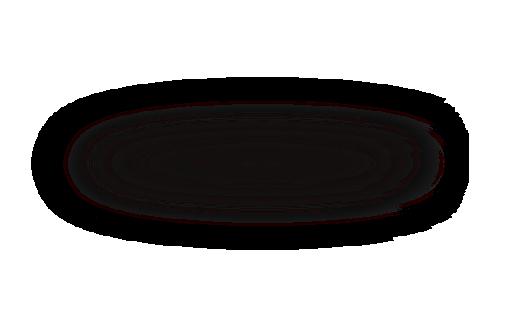
A wonderful, interactive game developed between the two, with much cheering from the residents, children and parents. Tom and his mother also started visiting Clara during the week and Clara told me that Tom and his family gave her a sense of purpose and reason for living. She lived until she was 103 and Tom was three when she died. A beautiful interactive photo of them both playing the drum together was on the cover of 'Sound Ideas Volume 6 Number 2 May 2003
Musical preferences-musical journeys through life Canterbury Studies in Music Education.'

Last winter I was visiting someone in a retirement village. I noticed a sad-looking woman in a wheelchair sitting outside with a younger woman in the last patch of sunshine. On the wheelchair tray was a box of chime bars. I couldn’t resist. I went over, smiled at them, opened the chime bars and played the woman a little musical question. She took the beater and played me an exquisite little musical answer that resolved on the note C. She looked straight at me and gave a smile as she passed me the beater.
We had a musical conversation that was so musical, playful, with much use of turn taking, matching rhythmic patterns, pauses and a wonderful sense of improvisation. After she had put the beater down to indicate that she had finished, her daughter told me that her mother had Dementia, couldn’t talk, and often seemed locked in her world. She was very moved to see and hear how she could communicate musically and said that this was the most engaged her mother had been for some time. She asked many questions about how and why the music worked and was excited about ways that she and the staff could initiate such interactive musical play with her mother.
This experience motivated me to contact the manager of Ryman’s Ngaio Marsh Residential Home about establishing a weekly Musical Play programme for their residents, together with families from my music school. The manager and staff were very excited about this idea. The aim of each music session is to give everyone a rich, predictable, sensory musical play session, opportunity to play together, to use narrative and instructional songs to keep everyone connected in the moment and to develop a sense of nurturing music community.
We started the music sessions in a beautiful big atrium. The residents were clearly delighted to see the children. We began with a ‘Hello Song,’ familiar action songs and nursery rhymes. Everyone came together in a circle through use of a large stretchy rainbow ring/co-operband. The sensory experience of bouncing the ring, moving it forwards and backwards, side to side together helped to develop good listening, timing, ability to follow a sequence of actions, and to establish a strong sense of synchrony. I sang an instructional song for the children to come and get a maraca. Everyone was given a maraca to play for a range of catchy music and dances.
"All players are equal or can be made so. Novelty is more fun than repetition. Rules are negotiable from moment to moment. Risk in pursuit of play is worth it. The best play is beautiful & elegant. The purpose of playing is to play, nothing more"JOSEPH W. MEEKER
BIO: Julie Wylie MNZM founded the New Zealand Musical Parenting Association in 1992. She was the founder of the musical play programme at the Champion Centre, Burwood Hospital, Christchurch, New Zealand, where she was the senior music specialist for twenty eight years. Julie has been invited to present music workshops and papers in many countries, including Korea, Japan, Singapore, Australia, the United Kingdom, Lithuania, Estonia and Finland. She has received awards for her music leadership, and her music resources have won international awards. Julie was made a member of the New Zealand Order of Merit in the 2018 Queen's Birthday Honours. She has her own music school for mothers and babies and children aged 0-8 years founded in 1990 and is the Director of the Postgraduate online training programme: “Certificate of Musical Play as Therapy.”

This was followed by a slow predictable action song in which every player stretched up high, brought their maracas down low, moved them from side to side, around and around, hid them behind their back and stopped on cue for the sung instruction …’now get ready to stop’. We finished the session with a traditional folk song using a large, floaty, colourful parachute that everyone could hold onto. We use sign language for the song 'Music Time Has Finished Now', followed by a Goodbye Song. Residents are aged from late seventies through to one hundred years. The children are aged up to three years. The first music session was clearly a success, as children became accustomed to the new setting, watching and starting to interact with the residents. Some residents preferred to sit back and watch, but others wanted to join in the play. One woman told me that it was about sixty years since she had been with children or held a child’s hand, as she had no grandchildren. She often becomes emotional watching them and joining their spontaneous actions and play.
At Christmas time we had a special Christmas music session. We began with our usual song routine then I introduced a very large red balloon. We threw the balloon in time to a beautiful

instrumental Christmas medley of songs. One man who always looked quite frail, stood, caught and threw the balloon with such strength that it sailed high into the air right across to the other side of the atrium where it was caught by another man who threw it to a child, who promptly threw it back. It was very moving to experience the joy, laughter and sense of playfulness as the balloon was thrown and caught by so many of the residents, parents and children.
When I sang the instructions for children to come and get their jingle bells, all the children started giving the bells to the residents. This instructional song provides predictability, helping children to know when to get their own instrument, give them out to the residents, cues them to collect these instruments and to put them back at the end of the activity. One little three-year-old noticed that one man couldn’t hold his jingle bells very well, so she curled his fingers around it and stayed right beside him demonstrating the actions. At the end she patted his knee, gently took his jingle bells, and put them away. When we finished our Christmas session everyone was smiling and singing along to our selection
of Christmas carols. 'Away in a Manger' was a deeply moving experience for everyone as we watched the children being rocked and cuddled by their parents.
This year our numbers of residents has increased, and we now regularly have up to thirty residents at every session. Friendships have formed. One beautiful child with Down syndrome goes around each week spontaneously shaking hands with residents or giving them a cuddle. He delights in being the star, demonstrating actions of songs, or initiating new activities such as using the sign for each animal in the song ‘Old MacDonald’ or blowing kisses at the end of the ‘Goodbye Song’.
A little girl enchants everyone with her dancing. Yesterday she ran on top of the huge parachute. Everyone was leaning forward watching and moving together as we gently undulated the parachute to my narrative song about her dancing actions. I noticed that everyone was smiling, everyone was in synchrony regardless of age or ability, everyone was emotionally connected, holding the parachute and playing together in the moment. The little girl was clearly empowered as she listened to the song about her, felt the rhythmic support,
the gentle sensory flow of the colourful parachute and saw the smiles of delight on everyone’s faces as she danced in the middle.

Every week I see how Musical Play is bringing about changes and development in relationships, confidence, timing, memory, energy, risk taking, playfulness, selfunderstanding and growth. Staff are helping, becoming more involved as they see the positive changes taking place in their residents. Parents are staying behind to talk to the residents, children and residents are playing together in the environment.
Musical Play helps people to become emotionally connected, mentally and physically playful, it develops a sense of wonder and creativity and brings generations together in the most moving, remarkable ways.
Julie Wylie
If you haven’t heard the song “Bad Hair Day” this year, then you might be living under a rock! Here is the story behind the song from Nelson-based teacher and composer John Phillips whose song “Bad Hair Day” has had 2.4 million posts and the combined views on these is now at 1.1Billion on Tik Tok.
I guess it would be fair to say I am a bit of an ‘ANNOYING DAD' sort of character when carrying out my crossing duty on busy Salisbury Rd outside the school where I teach in Richmond, Nelson. One of the local Colleges is situated on the other side of the road and I have always made it my mission in the mornings to shock them with a chirpy comment or joke … hoping for a two-syllable greeting in return but also content with a grunt! That is until a song I wrote 20 plus years ago “Bad Hair Day” went viral on Tik Tok. Once the connection was made my ‘street cred’ skyrocketed… ‘You actually wrote Bad Hair Day… sick!’ ‘You da man!’ From that point on, life with the lollipop changed forever - so many hi fives and congrats from the very same staunch teenagers that struggled to crack even a smile. It’s been hard to keep my mind on the traffic and delivering people safely across the road.
My work colleagues call me ‘Johnny Tok Star’...weird.
To be honest I’m still trying to get my head around how this all happened - I’m certainly uncomfortable with the attention and way out of my depth when it comes to social media at this level but one of the most humbling realisations to come out of this whole experience has been just how impactful our role as a teacher is - and I mean seriously impactful.
If you are like me, you just get on with your job - you don’t stop and consider exactly how many students you have taught over the years - you try and have fun with each new group that dances in and out your music room door - you hype them up - you send them back to class… sorry for that (Not!). I have learnt firsthand, through this experience, how/that we must never forget that each group that rocks up and sits down expectantly in front of us is comprised of individuals - each one goes home at night and talks about ‘stuff’ - hopefully some of the good stuff was about attending music class. Maybe they don’t talk about it …. maybe they don’t need to… it’s just something from the way you have treated them that has made them feel special and they tuck that away, forever. I have been reminded over the last few weeks of so many fun times involving ‘Bad Hair Day’ - hard to believe how it has lasted so long.
The Bad Hair Day story started over 20 years ago. But as I look back on 34 years of teaching, I can’t help but think I can trace back this little success to some key formative moments in my own teacher training and professional development that unlocked a talent for song writing.
Wellington Teachers' College was ‘the bomb’. To be fair - if the surf was up at Lyall Bay or there was cricket on at the Basin Reserve we called in sick, but when actually in attendance we had a blast. We sang in choirs (for fun!) - we danced creatively like no one was watching, we wrote songs with Laughton Patrick, we talked about arty farty stuff, we learnt to play guitar and ukulele and we practiced all these things together out in schools. We focused on developing skills that proved to be invaluable when we became real teachers and left us feeling confident teaching the Arts in the classroom, setting up a fun daily schedule.
No YouTube to rely on back then! How thankful I was in those early teaching years that I could pull out the guitar and calm the farm with a song! I can’t help but feel that this style of collegial learning, laughing at ourselves as we trained to be teachers, was critical. We were all in it together - those of us that had a few more skills on the guitar taught others. We made resources that I still use today.
In every job since my first at St Patrick’s School in Kilbirnie I was always the one in charge of finding assembly songs. Never an easy task. Will the kids like it? Nice tune but what about the lyrics? I can only find stuff about love and heartbreak. Assembly is tomorrow and I’ve got nothing! Then along came Kiwi Kidsongs! How I looked forward to that delivery every year. I have no doubt schools around the motu breathed a collective sigh of relief as they ripped open the packaging to see what musical treasures awaited on those… tapes. Singing sorted for the year!
For me Kiwi Kidsongs was a true turning point in my writing career. What if I wrote a song that got onto a Kiwi Kidsongs album?!
At Springlands School in Blenheim where I worked for 14 years, we had a school-wide focus on values, and I started listening more closely while on duty to what was going on - everything suddenly became a potential song! Respect for property… boring! That was until one of the mums fell into the huge “Lost Property Box” we had by the staffroom… brilliant. Song #1 sorted. The next song came to me while I was watching my son play soccer and seeing the behaviour of some of the parents on the sideline….not flash! Song #2 sorted: “My Dad Loves His Rugby”. And so it went on:
“Ma Te Mahi Ka Ora”, “The Wobbly Tooth”, “Marble Mania”, “Butterfly”, “The Red Dot Special”. Each song with a different values focus.
Despite having no studio experience, I recorded the whole album at home on an 8 track VS-880 Roland digital recorder - in an old, converted woodshed. The egg cartons on the walls were for visual effect rather than acoustic. I had to wait until the neighbors stopped arguing and the dog stopped barking to get a clean take. It certainly taught me to rely on my musical
ear and to hone my playing skills. I was a finalist in the Tui NZ music awards in 2001 - (not many entrants that year).
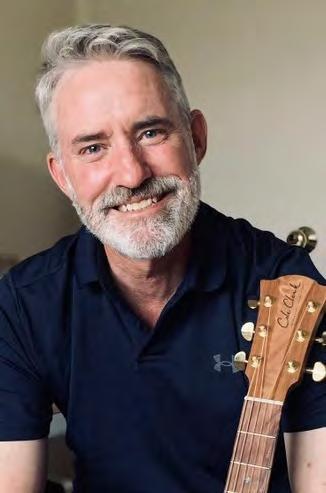
I submitted “My Dad Loves His Rugby” to Kiwi Kidsongs and it was accepted! I was stoked. That began a wonderful few years working with the amazing Janice Marriot and her team from Universal Children’s Audio. Other songs I personally had published on various Kiwi Kidsongs albums were “Ma Te Mahi Ka Ora”, “The Wobbly Tooth” and of course, “Bad Hair Day”, written in 2004.
School photos are always hilarious to look back on and we have all had moments I am sure where we have thought: “what was my mother thinking letting me out in public like that”? My son, who is now also a music teacher, had the frizziest mop of hair when he was younger - looked like dacron when he got up in the mornings…. like he’d been ‘fighting with his pillow all night’….. and there it was. Quick song to write too as they sometimes are.
Bad Hair Day was first published in 2004 on my own album of original music for children and then later on Kiwi Kidsongs 14 I had to do a little convincing at the time to keep the original feel to the song on this recording but in the end, I think all involved in the project would agree it has stood the test of time and still has that sassy upbeat feel that suits the subject matter. The amazing vocals by child singing sensation Theo Va'a really gave the track some added punch.

Kiwi Kidsongs has in recent years been made available online in the form of lyric videos on Vimeo. This updating of the resource was made with the financial help from the Networks of Expertise and the project was driven by passionate classroom and specialist music teacher Tim Carson. While teaching at the same school here in Nelson, Tim Carson and I had many conversations while teaching at the same school here in Nelson about the urgent need for a focus to be put back into developing the skills of classroom teachers to be able to confidently teach performing arts within their own classroom programmes.
- The need for more government funded music resources in today’s teaching environment is critical - good wholesome relevant songs that are professionally produced - pitched at the primary school yr 4-8 age bracket.
- More teachers playing instruments live while leading classroom singing!
- More quality professional development where teachers can build confidence to teach music, dance and drama.
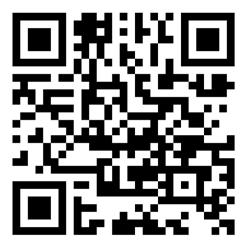

I for one am a teacher who is looking back on their career and feeling eternally grateful for the input given at teacher training level which allowed me to identify my passion and pursue it with confidence. I would never have written ‘Bad Hair Day’ had I not been given the opportunity or a reason to give writing a go.
Writing songs for children is every bit as enjoyable and fulfilling as writing for radio. It’s challenging and the audience is brutally honest. Sometimes you get it right and there is nothing more fulfilling than hearing hundreds of students singing your song back at you - lost in the moment.
BIO: John Phillips
There is a huge range of material available for primary teachers to use in their music programmes. Many fantastic resources come from overseas and have a valid place in our music programmes. They give children a world view of music and the opportunity to explore other cultures, though I am always on the hunt for resources that draw on the richness of our own culture and everyday life here in Aotearoa. I love the way that music is so easily integrated with learning in other curriculum areas that we are focusing on in our classroom creating rich accessible musical experiences.
The links between literacy and music are strong. We can use speech rhythms to create rhythmic pieces and/or use these speech rhythms to create melodies turning a poem into a song. A poem or story can open the door for wonderful musical exploration. Here in Aotearoa, we have a fantastic array of stories, poems and legends. Some stories have a natural rhythm, those that also have repetition often become favourites as children anticipate when to join in with a repeated line in the story.
One NZ author who does this well and whose stories have been enjoyed in many homes and classrooms is Dame Lynley Dodd, with her series of books about a little dog called Hairy Maclary. Her work has been well loved over the last 40 years so you will find her books in many school classrooms and libraries. I am aware that her books have been critiqued on the basis of giving a narrow range of gender representation. However, let's not throw the baby out with the bathwater. Within our music programmes we have the flexibility to be creative making changes and adaptations. What if Hairy Maclary had more dogs follow in line to the dairy? What would the new dogs look like? What would their names be? How would they walk? How would they bark? What if dogs were the pets of tamariki in your class?
You may find other favourite stories or poems that have interesting sounds, rhythms or repetitive phrases that could be easily used to create rich music learning experiences in your classroom. Perhaps use the words of the items collected by that sneaky cat “Slinky Malinki'' to create an interesting rhythm piece. Changing the order of the things collected or adding items Slinky Malinki might collect next time. In a similar way you could work with the words of the things found in “Down the back of the chair” by another great NZ Author Dame Margaret Mahy. Joy Cowley's stories about a greedy ginger cat also lend themselves well to musical exploration. Using legends or other stories about other journeys you could create soundscapes perhaps… even your own journey to the dairy!
I have found using a typical Orff Schulwerk process which integrates language, music, and movement leads to successful, fun music sessions. Children have the opportunity to explore movement and embody rhythms before exploring how these may then be played on untuned or tuned percussion. I love that within this process children are encouraged to bring their

own creative ideas to a composition. You can find out more about ONZA here. onza.nz/
I am sharing a series of learning sequences with you so that you can enjoy these stories in a musical way with your tamariki. There is a lot here. You may want to try just one or two activities or take your tamariki on a musical journey. My hope is that this experience may be the springboard for other musical learning experiences in your classroom.
MACLARY
NE - Year 3
Sing
•Teach the children to sing “Hairy Maclary from Donaldson’s Dairy” soh me style. Encourage children to use their hands to show the melody rising and falling. G E GG E GG E GG E – later this could become the intro to your story with some children playing on tuned instruments.
• Read the story with children joining in on “Hairy Maclary from Donaldson’s Dairy”
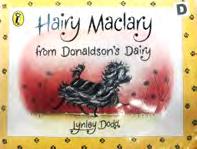
• Explore rhythms. Clap the rhythm of each dog name
• Describe the appearance of each dog – small, big, skinny… what would their bark sound like? Is there a link between the size of the dog and the sound it makes?
Move
Can you move like… Muffin MacLay? Schnitzel von Krumm? Take some time to explore the way the other dogs might move. Fast, slow, standing tall, heavy or light footed. Talk about movement words scurrying, trotting, prancing. What do these words look like? Ask the children if they can show you how the dogs they know move.
Percussion Instruments
• In groups of 2 or 3. Give each group a dog picture and practice saying the rhythm of bark words, eg. Bow-wow-wow-wow. You could write these words on separate pieces of paper for each group to refer to.
Hairy Maclary – Yap, Yap, Yap Muffin McLay – Ruff-Ruff
Hercules Morse Bitzer Maloney – Bow-wow-wow-wow
Bottomley Potts – Ro Ro Ro Ro Ro Schnitzel von Krumm – Yip yip
Scarface Claw – Wrowww-w-w-w-w-w-w
Consider whether your dog’s bark is high or low, loud or soft, short or long.
• Match each dog & cat to a percussion instrument. Let children lead the way with their choice of instrument and encourage them to give an explanation for their choice.
Create a soundscape using pictures from the story (plus any you have created)
• Explore playing the barking rhythms slow and fast. Each group plays their bark rhythm in turn at a regular/slow speed. When the Scarface Claw sound is made each group plays quickly in turn to match the story – representing the dogs running back home. You could finish this piece with a sigh – a sign that Hairy Maclary is safely back in bed.
Year 3 Extension. Can we add an ostinato sentence to your soundscape that keeps going underneath?
Eg. watch out for Scarface. This could be spoken or accompanied by a percussion instrument.
Further Extension Year 3 - 6
HAIRY MACLARY CATERWAUL CAPER
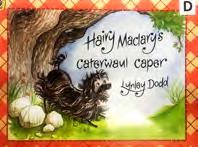
Exploring with voice
• Sort the dog pictures from smallest to largest.
• How does the size of the dog influence the pitch of the bark? Consider each different dog; would it bark fast, med, slow?
• Working in groups of 3 - 5, give each group a dog picture and matching dog bark words from the story.
• Practice saying the words rhythmically. You may want to give groups an opportunity here to create a new dog, drawing a quick picture and creating a dog bark sound – they could write this down.
Explore using percussion Instruments
Activity 1 Soundscape – re. creating the story with sound
• As a group, consider the size of your dog, how does this influence the pitch of its bark?
• Then choose a percussion instrument to match your dog. 6 dogs + Scarface Claw.
• Practice playing your dog rhythm using your percussion instrument.
• Share back one group at a time with Scarface Claw’s sound played in between each bark as in the story.
• Can we add an ostinato sentence that keeps going underneath? eg.“What’s that noise?” or “Who’s making that noise?” This could be spoken or accompanied by a percussion instrument.
• You could develop this piece to share with others.
• Using the dog bark rhythm words above, and any new ones you may have created, say with an accompanying drum. Notice how the barks naturally fit with the beat.
• Choose a conductor to point to one group at a time turning barks on and off. Repeat with different children as conductors.
• Experiment with layering sounds. The conductor could use both hands to point to two groups at a time. Give sufficient time to listen to how the barks work together before stopping one or both groups and listening to a different combination.
• How do these sounds fit into a 4 beat pattern? Are there any rests? Draw the bark sounds into a grid, similar to the one below. Notice which beats have a lot of sounds and which beats have less. Experiment with starting barks on different beats. What if Hairy Maclary started yapping on beat 2?
•With a drum keeping a steady beat, groups in turn make their dog sound.
• Try adding texture by layering sounds. Hairy Maclary keeps yapping and another dog is added. Continue until all the dogs are barking, recreating the scene when all the dogs gather at the bottom of the tree.
• You could experiment with changing the order of the dogs or adding new dog sounds. Discuss with your tamariki what way you like best.
• What if we were to put these barking rhythms onto a tuned instrument? Use the same barking rhythm to create a melody? You could have a xylophone or glockenspiel per group. Consider whether the bark is repeated on the same note, rises or falls. Allow time for children to experiment and choose the melodic pattern they like best. (You may want to consider using a C pentatonic scale – removing Fs and Bs)
• Encourage children to record their melodies in a way that they can share with others. Perhaps using a symbol or note letter for each sound. These symbols could rise and fall to match the pitch of the notes chosen.
• You could revisit the chart above with one or two children playing the newly created rhythmic melody and others in the group playing percussion instruments. Perhaps experiment with changing the order of the dogs to see which you like best.
If you used a C pentatonic scale for creating barking rhythm melodies you could try the “conducting circle” again, this time using the melodies created as all will work well together.

Suzanne Thom ONZA Wellington
Representative Suzanne has been working at Eastern Hutt primary school as a specialist music teacher since 2019.

I was very excited when I heard Judith had received funding from MENZA’s Networks of Expertise fund to create a resource for recorder suitable for use in New Zealand primary schools.

Kiwicorder does not disappoint! It features thirteen delightful original compositions scored for various combinations of descant, treble, tenor and bass recorder. Easy and advanced descant parts ensure the resource is accessible to a wide range of abilities. Two of the pieces are composed by Judith’s son Michael and the other eleven by Judith.
With superb backing tracks featuring some of Christchurch’s best musicians, a school which may have players with only a three note repertoire can still perform with an easy decant part against the backing track which will be satisfying for the players and entertaining for an audience!
Many of the pieces have titles reflecting Judith’s love for Christchurch and its surrounds and many have a backstory. For example, the first track, Limpet and Barnacle Rock where the name reflects the main rhythm of the piece was inspired by Judith’s early trips to the beach with her young children exploring the rocky shoreline. The word rock in the title is a play on coastal rock and the rock genre. The piece has parts for three descants at different levels
TranzAlpine Blues has a range of tempi reflecting the different speeds of the train as it goes up into Arthur’s Pass and back down to the ocean. If you listen carefully you can hear the train whistle.
Judith also explores a range of genres from gentle melodies through to blues and rock. Memories is a lovely lyrical piece written for a duet of descant recorder and another instrument which could be a flute or a second recorder. Go E’sy Blues is all about the minor blues in a laid back swing style and only uses 4 notes, E, G, A and B, for the melody with opportunities for children to improvise on the same four notes. Lyttelton is in the style of an Irish jig and reflects the fact that Lyttelton is the port where the ships first arrived with British settlers in the Canterbury region, bringing with them their musical heritage.
One of Michael’s pieces, Rock-Order could almost be considered to be in a heavy metal style and the children will love performing it with its funky backing track.
Another popular one with older children will be 8 Bit which is based on the old 8-bit gaming style of music, and it also has 8-bit binary coded messages in the advanced recorder part and the opening drum solo.
Along with a range of genres, Judith also challenges the players with some interesting time signatures – 5-4 Dance is just that and the main theme of Journey into the Void has 7 beats in the bar.

The final piece in the resource is a gentle soundscape titled Whenua which features the beautiful playing of Mahina-Ina Kingi-Kaui on taonga puoro along with some stunning imagery.
Kiwicorder will be free to all schools and will released as a digital resource with lead sheets, backing tracks, play-along videos and teaching notes. It is going to be a wonderful addition to our schools and will guarantee the engagement and enthusiasm of our tamariki as they learn this very precious instrument. Look out for it!
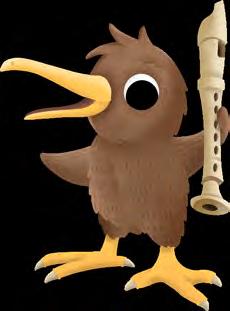


BIO: Celia is Music Director of the Christchurch School of Music where she also runs foundation music classes for pre-schoolers and junior school students and teaches flute, recorder and piano. Along with Judith she is co-director of a children’s music festival, Strum, Strike and Blow a festival for recorders, ukuleles and tuned percussion. With training in both Orff Schulwerk and Kodaly, she is a regular presenter of workshops in early childhood and primary music education throughout NZ.
byWe’re pretty big
With over 400 members, MENZA is one of the largest, strongest and most organised subject associations in New Zealand. We represent a broad spectrum of music educators, from ECE to primary and secondary schools, itinerant teachers, private tutors and more.
We’re delivering on professional development In the last 12 months, over 150 members attended professional development workshops, talks or events across six different regions. That is over a third of our members benefiting from MENZA PD opportunities around the country. Later this year, we are looking to provide opportunities for teachers in Northland and Nelson, as well as the main centres – watch this space!
We provide a platform to get your events noticed. We can help you promote events, activities and performances in your area by providing FREE event listings on our website. We also encourage members to join and share events on our facebook group – because music should be heard, shared, celebrated and enjoyed! List your event today. Visit menza.co.nz/events
We’re making some noise on behalf of music education. In previous years, our advocacy work for primary education saw MENZA interviewed on Radio New Zealand and featured in the Dominion Post and New Zealand Herald. We are proud of our advocacy work for instrumental music teachers, working with the IRMT to develop a teacher education refresher course tailored for ITMs that is now more affordable, relevant and manageable for all concerned.
We’re a powerful voice at the table. As the official subject association for music education, MENZA nominates and is represented by members on MOE, NZQA, PPTA and other advisory or regulatory education review groups. We listen to our members and advocate on your behalf to ensure that music education in New Zealand can thrive at all levels, all over the country.
We recognise the unique landscape of music education in Aotearoa. That’s why we provide local content, resources, research and teaching tools, written by New Zealanders with kiwi kids in mind. Our involvement in Hook Line and Singalong ensures kiwi songs are transcribed and shared to be used as a resource to sing, sign in NZSL and strum along to on your ukulele.
From practical tips on organising a recital or enjoying your school production, to researched articles on music psychology
and pedagogy, or thought provoking personal insights on creativity, inclusiveness and excellence, Tune Me In provides a platform to share teaching resources, knowledge and expertise relevant to music education in Aotearoa.
Our members are our greatest asset.
MENZA represents a committed network of music specialists and educators, many of whom give up their time and energy to support the music education community through presenting workshops, organising and assisting with music festivals and events, or simply by sharing their knowledge, ideas and experiences with other members. As a MENZA member, you are part of a supportive community of engaged, enthusiastic educators to learn from, collaborate with and celebrate music in all its forms.
We celebrate achievement - and work hard to make sure the unsung heroes of the music education community are recognised and always delight when one of our nominations makes it through to be recognised in the New Year’s and Queen’s Birthday Honours.
Spread the word. The more members we have, the wider your network of support and the greater the opportunities for collaboration and shared expertise. By representing a large and diverse community of music educators, we can stand up, be counted and influence change. If you know somebody who might benefit from membership, or may have something to offer other members, spread the word. Membership starts from as little as $34.50 per year.
Get your event out there! List your event on the MENZA website and share it with over 400 engaged, enthusiastic music education professionals at menza.co.nz/events.
Get involved. If you would like to help bring professional development opportunities to your area, have expertise you wish to share, or want to discuss how you can contribute to New Zealand’s music education community, we would love to hear from you. You can contact us at admin@menza.co.nz and we will be in touch.
Do you know someone who would appreciate becoming a MENZA member? Gift subscriptions are also available for just $34.50 (Including GST). Email admin@menza.co.nz for more information.
MENZA (MUSIC EDUCATION NEW ZEALAND AOTEAROA MĀTAURANGA A PUORO O AOTEAROA) IS THE NATIONAL PROFESSIONAL BODY THAT REPRESENTS THE INTERESTS OF ALL EDUCATION SECTORS IN THIS COUNTRY.
Singing. The power of singing. From the youngest child to the wisest soul, singing is simply amazing. Whether alone, in a small group, or in a sea of people, singing is simply amazing.
Whether in the shower, car, or a concert hall, singing is simply amazing. Singing is amazing.
(Credit: Vaughn Fleischfresser)
My response? Yes, yes, it is.
In a recent interview on Nine to Noon, author Julia Hollander (her book is titled Why We Sing) (The power of song: why we need to sing. 10.05am, 8 March 2023, Radio New Zealand rnz.co.nz/national/programmes/ninetonoon/ audio/2018880899/the-power-of-song-why-we-need-tosing) talked about how human beings are hard-wired to sing. In her work as a singing therapist, Julia works alongside people with dementia. She notes the memories that older people have about singing with their families, gathered in the front room, and trips to the music hall, where they joined in with the collective singing. She also discusses how with the rise
of technology, songs have become something we buy, not things we create ourselves.
This gave me cause to think about my passion for singing with children. I believe singing is a powerful force in a child’s life. Are we doing enough in our primary schools to offer our tamariki the benefits of it?
The well-being benefits of singing are well-documented. Research advises that group singing and access to music at a young age can improve educational outcomes. It can also contribute to overall well-being and self-confidence. The New Zealand Choral Federation (NZCF) was recently awarded a grant from the Ministry for Culture and Heritage to support and encourage classroom, school and choral singing in primary schools. As an organisation of singers, we know the power of singing because we have all experienced it. Having observed that singing no longer seems to be a daily part of the primary school programme in many schools, NZCF is planning to address this issue through professional support for teachers, the development of new resources and the updating and curation of existing resources. This will consist of professional
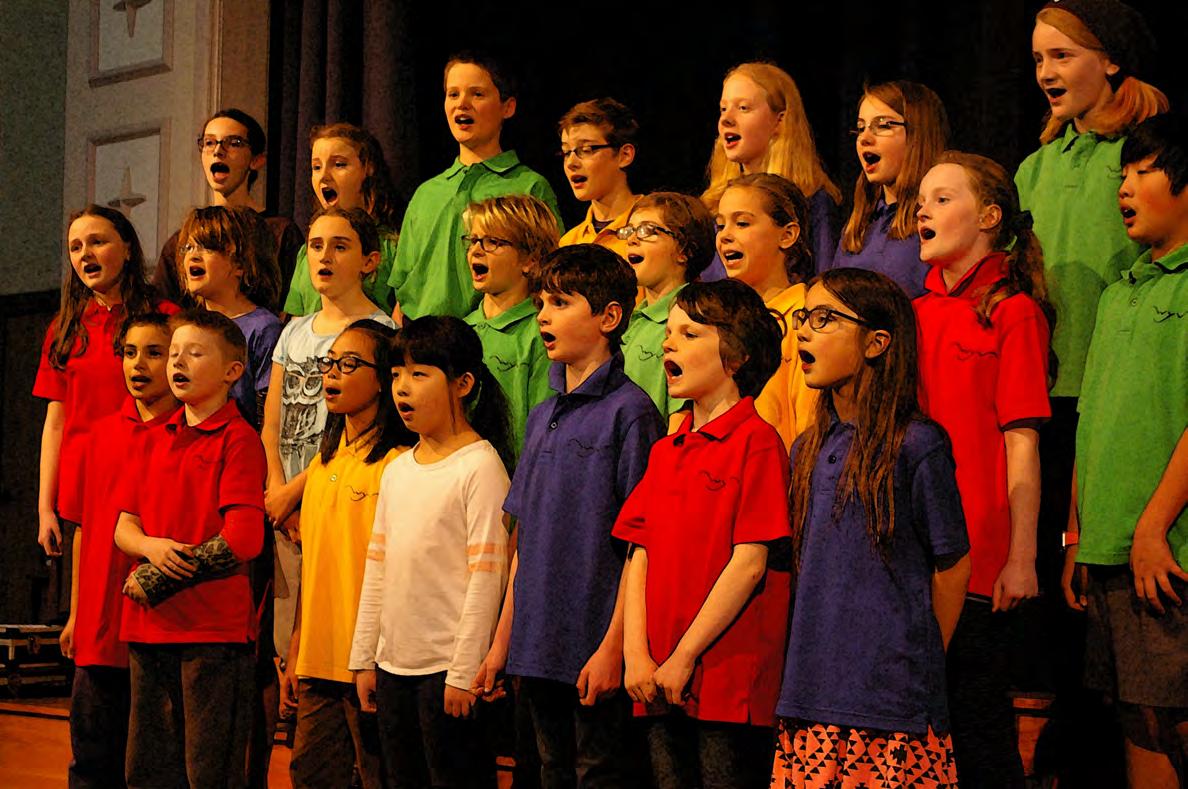
I opened Facebook this morning, i was greeted with the following post:
development workshops, face-to-face and online mentoring, and access to an expanding library of resources.
If you think your school has a well-established singing culture, we’d love to hear about how you have embedded this and what it looks like. Similarly, maybe you know of primary school teachers who would love some support in getting singing going in their classroom programme or school. In that case, we’d also love to hear from you. Or them!
Keep an eye out on Musicnet, the Education Gazette and social media for updates and locations of workshops.
To hear more about the project from NZCF Chief Executive Christine Argyle click this link: rnz.co.nz/concert/ programmes/three-to-seven/audio/2018874986/ funding-success-for-choral-singing
For more information, contact NZCF Children’s Outreach Co-ordinator Helen Acheson: helen.acheson@nzcf.org.nz
• Singing can be integrated into all parts of your day! Try singing the roll tomorrow. Or classroom instructions like packing things away or coming to the mat. Sing a song to cue children into a change of activity.
• There are lots of picture books that can be sung. See what your school or public library has.
• Speaking of texts: Choose the texts of songs with the same care that you choose other texts for study – are the words age-appropriate? Are they artistic? Will they appeal to children? Do they speak to children’s humour or sense of wonder about the world around them? Are they clever? Do they tell a story?
• With older students, use the words of a song as a literacy activity. Sing it and study it.
• Create opportunities for children to sing without accompaniment. This helps them to hear their own voices more clearly, which in turn helps them to develop a more secure sense of pitch and in-tune-ness. For the same reason, opportunities for children to singindependently are also powerful for learning.
• Singing games are a great way of introducing or embedding singing into your day. They are non-threatening, great for building community and cohesion among your students, and they are so much fun! Try one as a brain break next time you and your students need to move.
• Consider the pitch of the songs you are singing with children. We, as adults, often choose a singing pitch that is comfortable for us rather than thinking about what is appropriate for our students. Younger children especially have a naturally higher singing range because their vocal mechanism is smaller. If the song is a little higher, students will find it easier to sing in tune and with a confident, ringing tone that projects. Singing in a range that encourages students to sing rather than shout will help to reduce vocal fatigue and hoarseness.
• Sing lots of songs in lots of different languages. Maybe, if you have students whose first language is not English, they could teach you a song in their own language.
• Encourage children to sing songs from memory. Don’t always rely on having the words available. Children are much better at memorising than we are as adults, and it is good exercise for the brain.
• Singing is for everyone. Make sure your students feel supported and safe. Many children will come with lots of singing experience from their home environments, others with none. Let’s not create another generation of adults with horror stories from their school days about being asked to mouth the words or stand in the back.
The only way to get better at singing is by singing. And it is so good for us! Sing lots because singing is amazing.
What memories of singing will our students have in their seventies and eighties? Will they remember specific songs? Will singing help them to recall significant people or events? Let’s make sure they remember with joy how singing made them feel.

BIO: Megan is a choral singer, conductor and primary music specialist who is passionate about singing with children. As Artistic Advisor for the NZCF Children’s Outreach Project, she is keen to help teachers grow in confidence so that singing becomes a natural and joyous (and regular!) part of every primary school classroom nationwide. Generalist primary school teachers’ experiences with music education are the focus of Megan’s current doctoral study.


In the 13 years I’ve been at St Andrew’s College I have been involved with 23 musicals and have musically directed 21 of those (with another two we’re working on this year). As any high school teacher knows, to direct a school musical is a massive undertaking, and some would consider doing two a year as madness (especially as we maintain our full music department of 30+ ensembles throughout the year as well).
However, through much trial and error I’ve developed some workflows that make my job much easier that I’d like to share with any new teachers who are embarking on their first time musically directing a show.
Here are my top tips
1. Part tapes
As soon as we’ve decided what the show will be, I purchase the cast album from Apple Music and go hunting on the internet for pdf scores. Unfortunately, Reddit.com has shut down many useful forums where these were shared, but Scribd.com has proven to be super useful for this.
Yes, I am aware of the questionable legal context around what I am doing here, but I justify it knowing that we have already purchased the rights with the appropriate companies.
I have an ex-student who is a strong sight-singer and for mate’s rates she comes and sings all four parts of the ensemble numbers of the show for me while I record her singing along to the cast album. I then distribute the SATB parts for all the ensemble songs in the show to the cast.
Our year 11-13 show is on in week 2 of term 2. So, we auditioned in the previous November, and I had the part tapes out to the cast prior to the Christmas holidays so they could learn them over the summer.
2. Appoint section leaders
I have strong singing students lead each of the SATB sections. They need to organise their own weekly before-school sectional rehearsal where they use the part tapes to work on their parts. The students hold each other accountable if anyone is not good at showing up, but they know they can come to me if they need an adult to give a firm word to a cast member that’s not taking it seriously enough.
This results in an enormous amount of learning that happens away from my ensemble rehearsals, meaning I have to spend less time ‘note bashing’.
We have now developed a culture where everyone in the cast is also part of our senior choir which means the quality of our ensemble singing has greatly improved in recent years.


3. ROCS Showready tracks and cast album backing tracks
So that I don’t have to play rehearsal piano at all the cast rehearsals I make up backing tracks for the director and choreographer to use in my absence. If your show has the ROCS Showready app available for download then definitely get that. It might sound terrible as it’s using bad MIDI sounds, but it will be exactly the same as the score and will include all the underscore and scene-change music that the cast album is often lacking.
4. Budget for a good pianis
I know that budgets are often super tight. But it takes a massive weight off my mind knowing I have a good pianist pulling the orchestra along in my shows. I have an ex-student who has gone on to be a very good music theatre pianist and director and for mate’s rates he comes back and plays all my shows. While I have many ATCL and LTCL level pianists at my school, I find that while they are technically good, they don’t have the feel or the ability to ‘comp’ over chord patterns as is required by many shows. Yes, I could take the time to
teach them this skill, but if I’m focusing so much time on working with the leads and ensemble on their singing, I don’t have time to train a pianist from scratch in a genre they’re unfamiliar with. Having a good pianist in the mix makes the less experienced students in the band or orchestra learn their parts much quicker and help us develop a cohesive sound.
5. Get the singing teachers on board helps us
It’s a requirement of someone in a lead role in our shows to be getting singing lessons with our Itinerant singing teachers. The teachers do a fantastic job at teaching the songs to the lead performers. I make sure the teachers have the music and more importantly, my vision for the part so that they can give good advice to the students. I usually have to get the students to interpret some phrases in a different way once we get into tech and dress rehearsals as a result of how they’ve been taught the song(s), but this is usually an easy fix.
6. Involve the sound crew early in the process
Our shows usually have students run the sound, but I do hire a professional to be at our first tech rehearsal and dress rehearsal to make sure the mix is in a good state. Often the students just need to turn the appropriate faders up and down. This may seem like an easy task with a digital mixing
desk where we have pre-programmed all the scenes, but it’s surprising how challenging it is for student mixers to get the right levels, particularly as actors enter on stage and start saying their lines.
Therefore I insist the students come to as many rehearsals as possible with the script well in advance of the first ‘tech’ rehearsal so that they can get used to the pace of the show and where all the critical moments are that they’ll need to go away and work on.
For our year 11-13 show we do a four-day production camp from a Friday-Monday mid-term 1. We get through a massive amount of work. However, what is probably slightly different



about these weekends is I also make a music video of the cast rehearsing. This helps the cast focus and work towards a goal but it’s also really great for promoting our show.
Over the last two years we have done shows that are not well known by our school community: "Songs for a New World" by Jason Robert Brown and "Bright Star" by Steve Martin and Edie Brickell. Producing a video of the cast singing the opening numbers from these shows has been great for getting friends, family and staff along to the shows. We need to sell 1200 tickets for each season so every bit of promotion can help!
If you’d like to see the promo for this year’s show filmed on location at Hanmer Springs Forest Camp go to: tinyurl.com/StACBrightStar

The video production doesn’t need to be super flash, just record something on your phone and get it out there. If you’d like instruction on how to produce music videos like this to a high level, my Mixing Techniques for Teachers Course covers this in the Beginner course. Head to learningideas.org/teachertrainingcourses for more info. Alternatively, bring some students from your school’s TV/Film/Media classes to shoot it all for you. They could probably even get some credits for it ;)

8. Develop a strong friendship with the other staff At StAC I am so blessed to work with two amazing directors for the two musicals. Central to the success and enjoyment of our shows is the fact we all know our roles, keep out of



each other’s way, and respect the amazing work each of us do. We have worked at this over the years so that when we get a little bit grumpy with each other in the stress of getting the show on, we know that our relationship and respect for each other runs far deeper than the odd disagreement.
While we are far from perfect in our dealings with each other and the kids at times, by keeping things overwhelmingly positive for the most part we create a safe and caring environment that we love to be a part of.
Because if I didn’t love it, there is no way I’d be doing 20+ shows for a school!



Australian presenter Nick Peterson’s workshop on improvisation, at IRMTNZs Mini-Conferences 2022, offered fresh perspectives and effective ideas for teaching. Dianne James reports.
The overarching theme of Nick Peterson’s discussion throughout his series of interactive lectures was his belief that music is a language. He made numerous comparisons to the way we learn our native language and how we might think about the way we learn and teach the language of music. He equated the individual note values (eg semiquavers, quavers) with letters that are combined into words (rhythmic cells); these rhythmic cells further combine to create musical phrases, sentences, and paragraphs of, for instance, 2/4/8/16 bars. To these rhythmic phrases are added all the other musical elements: melody, harmony, timbre, texture, structure. The result is a well-structured, coherently organised piece of music.
Sadly though, as Nick commented, music education is at the mercy of the syllabus - meaning that much of our teaching is devoted to deciphering the language written down by others, a result of the exam-based culture that permeates the environment in which we all live and teach. We and our students become good ‘tracers’ of the music, experts at recreating someone else’s intentions, but we are often reluctant and scared to create music spontaneously.
So how might we initiate and nurture improvisation in our students? Nick’s advice was to “just do it” but start small, for instance playing the black keys of the piano (an easily found pentatonic scale), or providing a harmonic basis (such as a 1-5-8-5 bass line - C-G-C-G in the key of C) over which a melody might be improvised, or using a 4-chord harmonic pattern (eg I-vi-IV-V7).


Through this process we and our students can gain some instant gratification, without the need for maintenance through rigorous and regular practice. Consider how this differs from the process of learning an assigned piece: we first select the piece to be learnt, decipher its code, practise it and refine our technique so that we develop the tools to play it, and interpret the written language based on our knowledge of the composer’s style. Once we’ve learnt the piece, we must practise it regularly to maintain it in our repertoire. Not so with improvisation!
As we develop an understanding of the different musical elements, we also establish the foundations needed for spontaneous music-making. Just as we can hold conversations with our family, friends and colleagues without scripting everything in detail, so we can initiate musical conversations through improvisation. Music is after all a creative art, not just one in which we interpret the music written down by others.
For me one of the ‘takeaways’ from this workshop, and indeed the whole Mini-Conference, was that music should be fun - after all we use the word ‘play’ when we talk about playing an instrument. The process of improvisation is a means by which we can “put the fun back into a fundamental musical activity.” Nick’s presentations certainly exuded joy and fun and his manner of delivering his richly illustrated workshops proved infectious!
Nick Peterson (Australia) is a music educator, performer, composer and author. A classically trained graduate of the NSW State Conservatorium of Music, he is also adept in synthesizer technology, and is experienced in playing a broad range of styles (Jazz, Latin American, Rock, Soul, Ethnic, and Funk/Fusion).
Nick asserts that adequate education in a creative art form such as music should go beyond generating re-creators, producing instead unique, independent, and creative musicians. This article first appeared in Ritmico Online November 2022. Republished with permission of the Editor.
“Music: it’s just meant to be fun!”
Trinity’s Musical Theatre exams have a reputation for developing talent through an emphasis on the synthesis of singing, acting and dancing to achieve a fully integrated performance.

The industry-driven nature of the exams means that students are trained in skills that are authentic to the requirements of work and study in musical theatre.
To find out more visit: trinitycollege.com/musical-theatre
TEACHER TRAINING IN MUSIC TECHNOLOGY COURSES
Mixing skills are critical for any student that wants to share their music with the world.
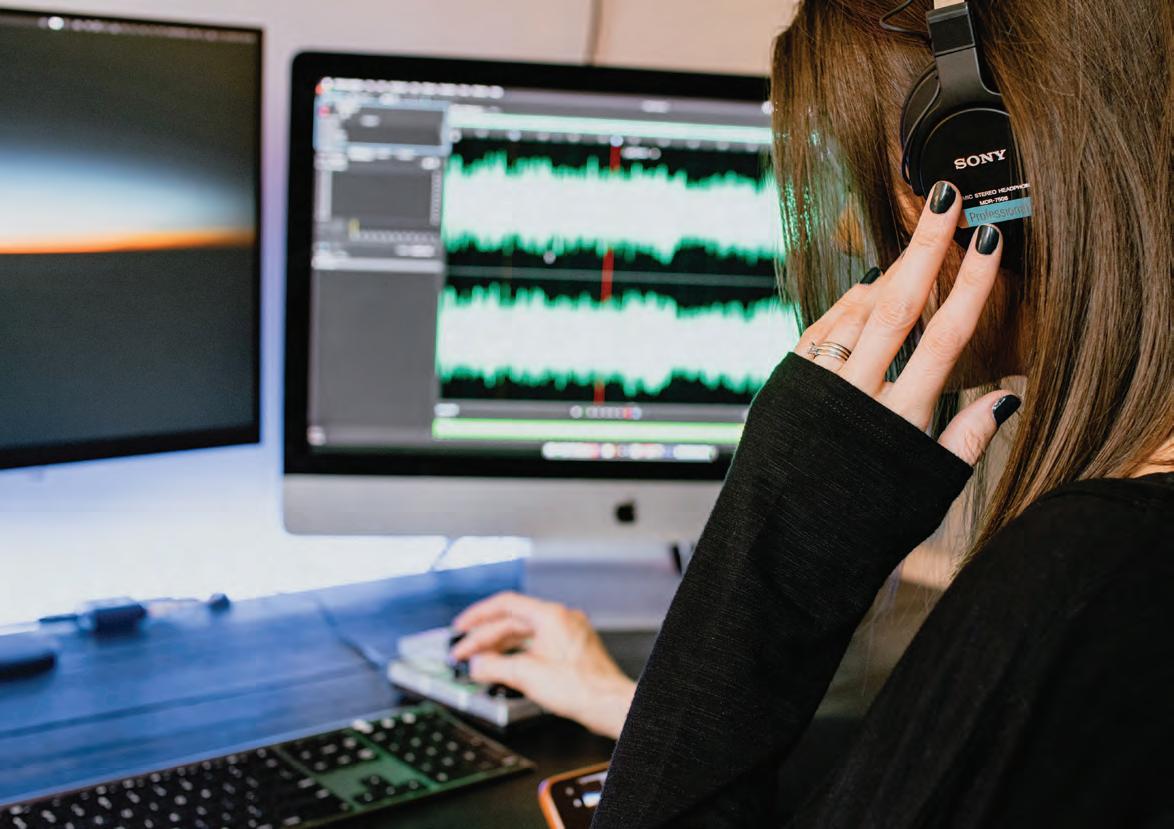
Having completed the beginner course, I feel confident going forward in mixing and using this knowledge in my classroom teaching.
Dragana Yelavich
ST CUTHBERT’S COLLEGE, NZ
BEGINNER COURSE
6 WEEKS
Overview of DAW’s
Balancing Tracks and Editing Using EQ
Reverb and Delay Effects
Recording Live Music
Exporting and Sharing
INTERMEDIATE COURSE
6 WEEKS
Basic Principals of Mixing Using EQ Reverb and Delay Compression
Loudness and Peak Limiting Controls
Chorus and Flange, Teaching Mixing to High Schoolers
www.learningideas.org
ADVANCED
COURSE
6 WEEKS
EQ, Editing and General Mix Techniques
Advanced Compression
Noise Gates and Drum Replacement
Shaping Tools
Instrumental Mixing Techniques Pt.1
Instrumental Mixing Techniques Pt.2
/TrinityArtsUKII have to start with an apology for this ‘click-baity’ title. As much as possible I don’t try to differentiate my students between those that are ‘techy’ and those that are not. Or even worse… the tech vs classical kids.
I truly believe that incorporating a variety of tools such as recording software, MIDI sequencing, sample libraries, etc., can be useful for ALL students, no matter the genre they want to specialise in.
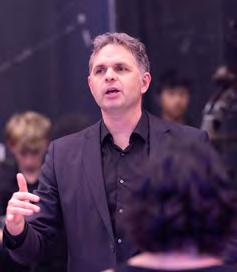
That being said, in our current (and soon to disappear) high school assessment system the students that have not been strong music notation readers have been at a massive disadvantage and have not adequately had their aural skills improved. The dwindling numbers of students sitting the level 1-3 aural exams demonstrates that teachers are not seeing the point in getting students to sit the exam if reading music is not part of their daily practice as musicians. The orchestra or jazz band kid has a massive advantage over the singer /songwriter or rock kid who is too busy reciting “Every Good Boy Deserves Fruit” in their head while trying to work out the direction of a melody.
So, what should we be doing for those students who are not the ‘notation reading’ students? Here are a few tools that you might find useful to help students develop their ear in identifying pitches, tone and timbre.
synth sounds using the software instruments available in our DAWs such as GarageBand and Logic Pro. Syntorial is a fantastic tool for helping them understand how to adjust the parameters of a synth to match the sounds from the recordings they are analysing. And it helps them to do it all by ear. Syntorial does cost money, but the first 40 or so lessons are free, which is all I’ve ever used with my students.

There are a few apps available for iOS, Android and Mac/PC but this is my favourite. When trying to mix a song we try to blend the tone of various instruments to make sure we don’t get a build -up of too many frequencies making something sound ‘boxy’, or ‘muddy’, or ‘harsh’ or ‘sibilant’. The ability to quickly recognise those frequencies, assign a number to them (such as a ‘honking’ sound being between 500-1000 Hz) and then pull those frequencies out with an EQ is an essential skill for a good sound mixer (or basically anyone who is composing and producing their own music).
Ten minutes a day with Quiztones and students will be amazed at how quickly their ear skills improve making them more aware of which instruments sound good together and those that don’t.
This is a great tool which teaches you about synthesis. It breaks down all the parts of a synthesizer and shows you how they generate and manipulate sound bit by bit. But the clever part of this training programme is that after it introduces a new part of a synth, it tests you on how to use it in an ear test where you must match the given sound with sounds that you manipulate.

So not only are students learning how a synthesizer works (which means this is fantastic for doing Level 3 Unit Standard 32304 – Operate a Music Sequencing Application), they are also making their ear more sensitive to changes in timbre (after all, timbre is a musical element just as important as melody, harmony, or rhythm… isn’t it?).
This obviously has great benefits for students who are composing in genres that use synthesisers (which is pretty much all modern ‘commercial’ related genres) but I also find this great for students completing Achievement Standard 91422 – Analyse a Substantial Music Work. I don’t have the whole class studying the same set work; instead they choose their own works to study. For those analysing something in a modern genre it is a requirement for them to recreate the sounds, which means finding ways to recreate the
For the student that is serious about becoming a sound engineer, probably my favourite tool is this website. It’s not cheap, but the variety of tools you can use to help learn how to be better at EQ’ing, hearing compression, identifying balance and panning issues, etc., is brilliant. The daily workout takes around 10 minutes and is basically all you need to do over a period of time to develop ‘golden ears’ for sound mixing.
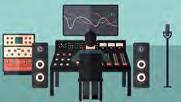
A popular alternative that is worth looking into (but I haven’t used personally) is trainyourears.com
As we go through the changes for a new assessment system and we ‘reinvent’ how we teach and assess aural skills, these tools may be of great assistance to high school teachers and may be more engaging for some students than the ‘traditional’ methods. Duncan
Ferguson.BIO: Duncan Ferguson is the Head of Music at St Andrew’s College and managing director and resource writer for learningideas.org. He runs workshops and six-week courses for teachers helping them develop skills in sound mixing and music production. Many NZ and Australian teachers have completed these six-week courses. To find out more please visit learningideas.org/teachertrainingcourses
The effective integration of technology into your music program can provide huge benefits in student engagement and learning outcomes. But successful integration requires careful planning and a solid understanding of
•current best practice
•evolving curricula and technology
•ICT and classroom infrastructure
•budgets and funding options
•professional development needs
Music EDnet has been working with teachers, ICT staff and decision makers at all levels of education for 31
years in Australia and 6 years in NZ, with industry experience spanning more than 45 years. In that time we have designed, installed and commissioned hundreds of music and digital media labs and a huge range of music, audio, video and lighting technology in schools across the region. This includes multi-million dollar performing arts building projects.

Let
•Music & Media Software
•Computer Music Hardware
•Audio Recording
•Live Sound & PA
•Instruments
•Video Recording & Streaming
•Lighting
•Training & Support
•Facility Design & installation
•Consulting
•LIVE production
•Streaming
•Professional Development
Day of Technology in Music Education
Presented since 2014, the Music EDnet conference returns in 2023 for live and on-line attendees.
Those of you with an eagle eye will see that my sign off includes a new acronym, NAA (National Assessment Advisor) which replaces the NAM job title. The NAA title reflects how the job has evolved into more of an advisory role, particularly most recently with the Review of Achievement Standards (RAS).
I also work with many more contractors than previous years. In 2023 I will lead a team of 20 kaiako moderators from across the motu who are front loaded to moderate new Level 1 internal standards in 2024. It is exciting to have such an incredible team of experienced assessors who individually bring a wide range of teaching and musical skills to the moderation whānau.
When you have a moment, please read the latest NAA Newsletter which summarises moderation observations from 2022. The standards chosen for the ‘Insights’ section are our top four Level 3 standards, 91416 (Solo), 91418 (Group), 91425 (Research) and 91849 (Song writing). These are the standards the majority of ākonga are selecting to be assessed in nationally.
nzqa.govt.nz/ncea/subjects/music/nmrs-3/february-2023/
There are five times as many schools trialling Level 1 RAS standards this year from the mini pilot in 2022. This will allow for a wider range of potential exemplars and resources for when the Internally assessed standards 91948 and 91949 are implemented in 2024.
Over the last couple of months digital submissions have been proving more difficult to access. Please do not forget to make your permission settings for Google Drive links set to “anyone with the link can view.”
These can be accessed using your Education Sector Log on to our Pūtake website.
The new Making Assessor Judgements course for 91425 Level 3 Research is now live for teachers to enrol in. The course consists of a range of learner evidence, including full exemplars alongside moderator commentary. You also get the chance to make judgements and receive feedback on your selections.
You can further support your assessment practice with these generic courses:
• Assessment – Reviewing your Practice
• Culturally Responsive Assessment
• Tāku reo, tāku mahi – My voice, my work (Authenticity)
• Why Less is More nzqa.govt.nz/about-us/events/assessor-support/
All the very best for your assessments this term and thank you for all you do in setting ākonga up for success in NCEA Music.
Hei kōnā mai Delysse Glynn NAABIO: Delysse Glynn, National Assessment Advisor for NCEA Music. I’ve been in the role for 10 years and over that time have led a very consistent team of contractors, who like you, are secondary school music teachers. Recently, the team increased from 5 to 13. This is to prepare for the increased workload that RAS will create. It is a privilege to work alongside these highly experienced teachers and hear first-hand the peaks and troughs of music teaching. As a communityminded individual I’m involved in the Auckland Bagpipe band scene as a drummer in the City of Auckland Pipe Band and perform regularly with a wonderful group of musicians at the Cathedral of St Patrick and St Joseph, Auckland. Like all community music groups, we’ve struggled through Covid-19 restrictions and mandates. It’s made me realise how important these groups are for my mental, physical, and social wellbeing. At least my other hobby, learning Italian, could be held on Zoom!


This year, in the Far North, taonga puoro noho marae wānanga have continued to evolve and expand. The Taipa Area School initiative, led by music educator Christian McDonald (Ngāti Kahu), has gone from strength to strength with over 60 students attending the most recent wānanga in September at Te Paatu Marae in Kaitaia.

The week long noho marae wānanga model was first explored back in 2018 after a series of conversations between Taipa Area School music educator Christian McDonald and other local educators including carver Darren Pivac and teacher and raranga expert Kylie Simeon. Together they decided to actively respond to a deeply felt need to bring education back to the whenua. They wanted to create an opportunity where they could explore the potential of placing taonga puoro at the heart of a locally designed, te ao Māori centred, holistic and place-based curriculum. They connected with taonga puoro expert James Webster and taonga tākaro expert Wiremu Sarich, and with this team they held their first noho wānanga at Maitai Bay in a single tent with 16 level 1 NCEA students in 2019. The kids loved it and the kaiako loved it. Taonga were
collected directly from the moana and the ngahere. Time was spent in shared kōrero around possibilities, for not only offering place-based learning for taonga puoro NCEA credits, but nurturing a te ao Māori centred pedagogy and praxis, which placed active exploration, natural discovery, play, hauora, wellbeing, and creativity at the heart of learning. The consensus at the end of this first wānanga was to keep going and to do more.
Since then, the team have been growing their relationships and networks in the region and moving the wānanga onto marae, first to the local marae Haiti-tai-Marangai in Whatuwhiwhi and then, most recently, to the larger marae, Te Paatu, in Kaitaia. Taonga puoro experts Horomona Horo and Kelly Kahukiwa joined the teaching team early on. This addition to the team of facilitators strengthened connections with the Haumanu Collective and also to Kelly’s work in holistic wellbeing and rongoā through sound vibrations and connections with te taiao. This year Kapa Haka teacher Latoya Leef-Graham joined the teaching team, further extending the learning possibilities of movement, kapa haka, and waiata for





students. Together, their work centralises Māori expertise and knowledge and privileges Māori ways of being, thinking and doing1
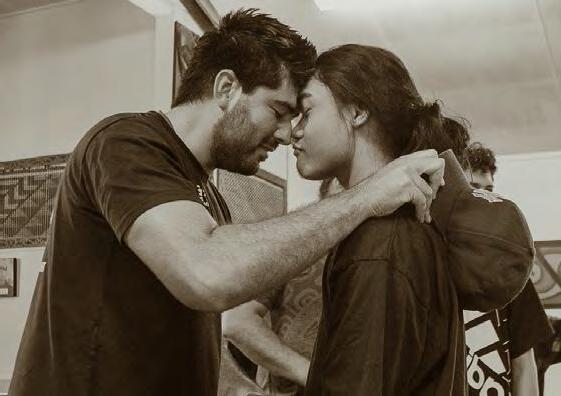







There have now been four wānanga in 2022 with some of those first students from 2019 progressing to level 3 taonga puoro NCEA credits. There are now opportunities for students to gain NCEA credits in health and physical education, hospitality, and leadership as they get involved with taonga tākaro and catering alongside taonga puoro learning. While the same credits have been achieved by students across the different wānanga, the learning in each one has also gone far beyond any pre-planned outcomes. Because it is the people that come into the space who create the wānanga, each one has been unique in terms of the additional learning that has emerged. A huge amount of un-planned for learning has simply unfolded through the emerging relationships with each different marae, the stories held in each place, the people, and the materials the students have been enabled and supported to work with.

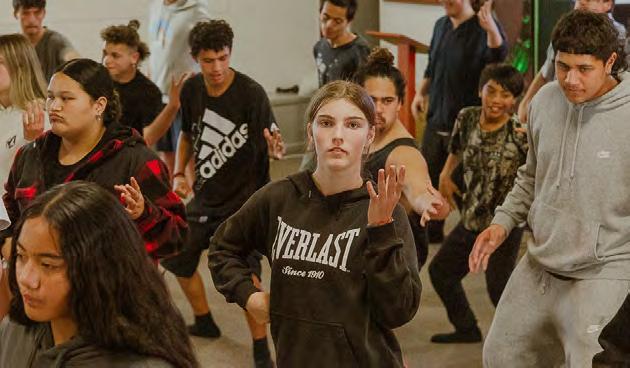
BIO: Priya Gain is a teaching fellow in the School of Education at Te Herenga Waka, currently teaching music, drama for learning, and professional practice. She has a research and teaching focus on aesthetic education and bicultural relational engagement through the arts and ngā toi Māori. She is currently completing her doctoral studies at the University of Auckland, Te Puna Wānanga, School of Māori and Indigenous education.
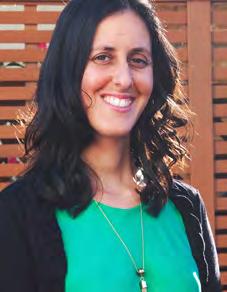
‘Tai Orooro Tai Auaha’ was the name devised this year for this growing kaupapa. The name connects the vibration of people with creativity and the local environment, which is strongly connected with the tides. Tai Orooro Tai Auaha captures the idea of vibrations being central to all learning - the rubbing together of materials, people, and ideas. As Kelly Kahukiwa reflects:
“What I’d like to see more of in the future is that the kids actually be creative with the puoro, the taonga, they start learning and getting so comfortable with them but they understand the atua and the tikanga that’s involved, that’s mean kaupapa… There’s no better place to do it really than up here because you’re right near the moana, the ngahere, they understand what all this stuff is related to.”
Through the wānanga students gain confidence in trying things out as they are enabled and supported to learn through exploration, play, and creativity. They are guided to connect to themselves and each other, and to attend to their hauora in a device-free learning space. Facilitators create an environment that offers a wide variety of activities and materials that students are invited to engage with in their own time. Wiremu Sarich reflects:
“Watching them blossom, bring themselves out…. when no one else is watching or when they are in that space where nobody’s sort of controlling what’s happening they reveal their true abilities and all we’re trying to do is show them they can do that…. what drives a lot of us who work with our rangatahi is actually watching them transition from one space into another and seeing the pennies drop little bit at a time.”
As students gravitate to different corners of the marae, whether it be to whakairo with Darren, raranga with Kylie, mahi whai with Wiremu, freestyling with Horomona, or engaging with peers in their own small wānanga as they emerge, they become engaged with the whakapapa of the marae space. The atua, the tikanga, and the pūrākau and ancestral stories and knowledge sit in the walls of the marae inviting engagement from the kaiako and students. These
things are also enacted through living together in the space of the marae over the week. The students are offered a variety of pathways and different kaiako energies to engage with the knowledge embedded in the space, including through taonga puoro, the pou, the tukutuku, the whāriki, the ancestors on the walls, the raranga, the whaikōrero, the waiata, the kapa haka and more.


A recent series, ‘Ngā Taonga Tuku Iho’, challenges educators to think how they can enable and support young Māori to connect with their taonga tuku iho. Storyteller and pūoro practitioner Khali Meari says:
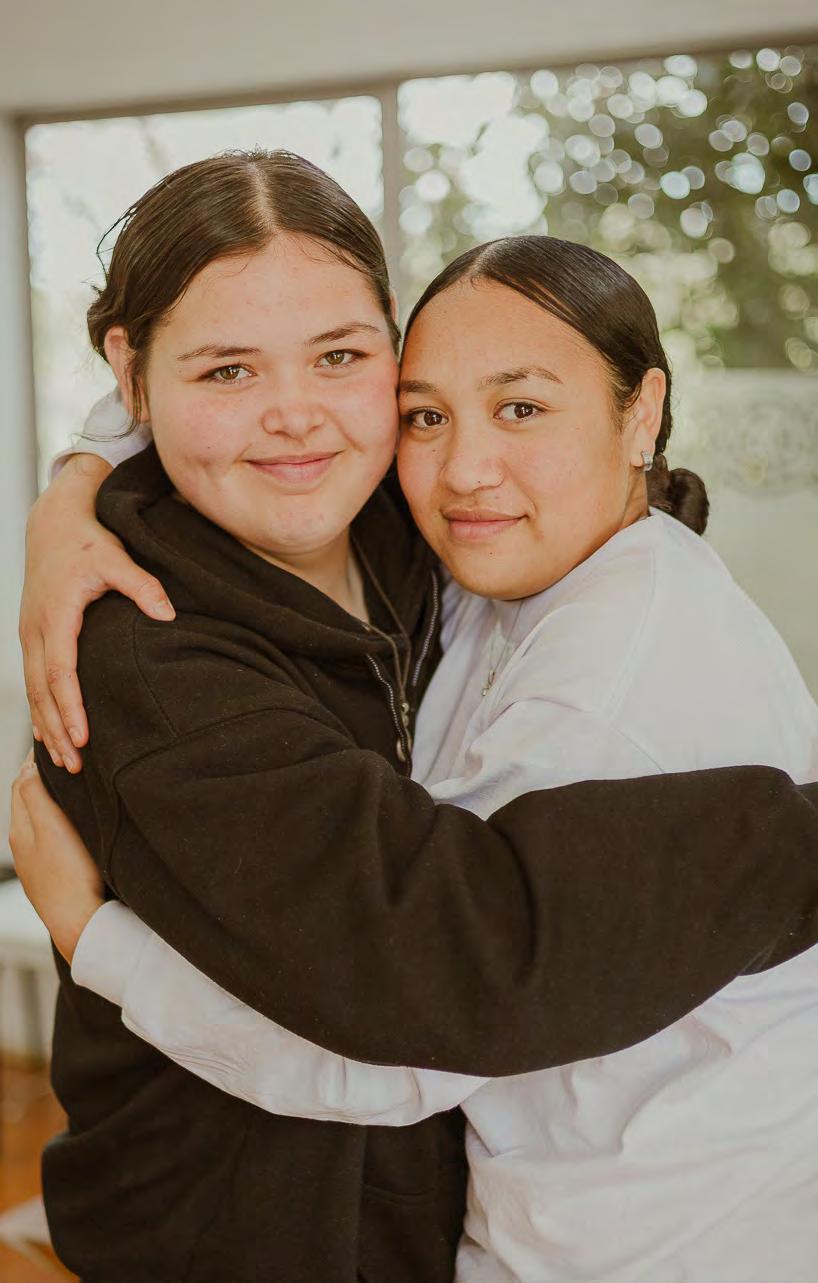

“It's painful to reflect on the impact our colonial histories have had on these taonga. It's up to us [the next generation of Māori] to relearn these techniques, to reweave these kōrero, and to be the here [the cord/tie/fastening] that bind our taonga tuku iho to the modern world"2




The noho marae wānanga initiative growing and developing in the Far North offers an educational space for kaiako and students to relearn together and to enable young Māori to be the here that bind taonga puoro to the present and in the future. Horomona Horo shares his aspiration:

“Hopefully the students…. they hold and grasp some of the things that they’ve been learning throughout this week and know that they can hold it and that can be a part of their toolkit to wherever they end up in the future”
The wānanga puts the taonga directly into the hands of young Māori and invites them to play and be creative with them in order to help them reweave new connections. As one student, Ati, on the noho said “Our generation is the generation who has to reawaken the taonga puoro because it was lost in the older generation.” Another student, Darius, reflected: “It’s good that we as Māori, or people of NZ, are learning the knowledge that our ancestors were meant to pass down”.
Kahu Kutia, director of ‘Ngā Taonga Tuku Iho’, reflects:


“For a long time, museums and archival institutions have been a place where our taonga have been locked away; disconnected from the places and people whose stories they tell. Often they are hidden away in private and public collections, slowly trying to find the right home again. And here we are, often desperate to have a relationship with these taonga, with our korero tuku iho. But the world of museums and archives isn’t
easy to navigate and sometimes accessing our mātauranga Māori can feel impossible….How can we gain access to our taonga, how can we breathe new life in these connections, and what do we dream of for the future of taonga care?”3
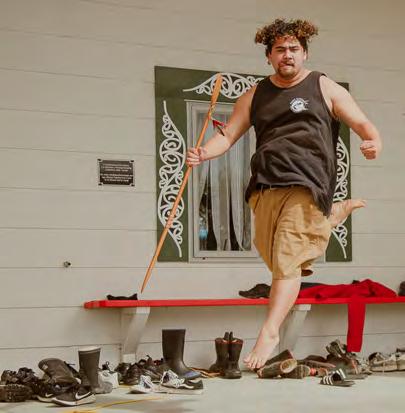

The noho marae wānanga is a powerful answer to these questions and an educational movement to be excited and inspired by. The noho marae wānanga model is a dynamic space where Māori kaiako are exploring and extending the boundaries of what place based local curriculum can potentially be for their young Māori learners and their communities. It has been great to have MENZA give priority to the recognition and support of Māori led educational initiatives, including these taonga puoro noho marae wānanga. In October MENZA also supported Wiremu to travel with me to Invercargill to share a co-authored research paper on the noho marae wānanga initative at ANZARME4 It was clear in the responses of those that attended our presentation that this mahi is an important part of supporting generative and mutually beneficial bicultural relationships in music and arts education here in Aotearoa. With current moves towards engagement with mātauranga Māori and mana whenua in support of local histories and place-based learning the noho marae wānanga offers a valuable example of what is possible.
a “mana of economy” in education. tandc.ac.nz/tandc/article/view/394

2 Ngā Taonga Tuku Iho #1: Lost in the Colonisation Machine: youtube.com/watch?v=yG9JaDWIrAo
3 tepapa.govt.nz/discover-collections/read-watch-play/ watch-nga-taonga-tuku-iho





4 anzarme.com.au/44th-conference-2022-new-zealand/


 BY CHARLOTTE PREBBLE
BY CHARLOTTE PREBBLE
The marae stay was an incredibly fun and educational experience. I found that the teaching style was very handson and relaxed, and that it was an environment that I could easily learn in. It was refreshing compared to the usual school approach of sitting people down at desks in stuffy classrooms and talking at them. It was a good opportunity for me to get out of my comfort zone and to learn new skills that I might not have otherwise learned.
The chance to learn new harakeke weaving skills was something that I had looked forward to a lot before I arrived on the marae. Weaving is something that I enjoy doing, and I wanted to learn some new techniques and patterns. I was not disappointed. My favourite new skill I picked up on was learning to weave a two cornered kete. I had previously known how to weave a four cornered kete but this pattern was new to me. After I wrapped my head around it they were extremely fun to make. I made two.
At the end of the marae stay we put on a whare tāpere performance to highlight everything that we had learned and achieved during the week. We started by welcoming in family and friends with a waiata, which we had been taught during the week. Then we moved on to a skit. The skit was our interpretation of the creation story. We were split into four groups, and each group was given a part

of the creation story to work on. We had to find a way of showing the audience our part of the creation story, incorporating what we had learned. My group was tasked with what happened after the separation of Rangi and Papa, how that land flourished, and how the humans took from it. To represent this we chose to act it out. Everyone was given a role, including narrating, playing taonga puoro, playing a tree (we used woven harakeke flowers to represent this!), playing a woodcutter, and many more. While we focused on acting, other groups focused on taonga puoro or mahi whai (string games). As each group did different things we were able to weave everything together to create one giant showcase to highlight everything that we had done. After the skit we finished off the show with a haka, which we had again been taught over the course of the week.
I found that the skit was my favourite part of the show as I like acting and enjoyed the small part that I was able to play in the performance (I was a tree). That being said, I found both the waiata and the kapa haka fun to learn as well. I haven’t done much kapa haka in my life, only doing it occasionally at school. As a result, I found myself pushed out of my comfort zone a bit. However, I believe that pushing yourself out of your comfort zone is a good thing; as Stephen Covey said: “To achieve goals you’ve never achieved before, you need to start doing things you’ve never done before.”

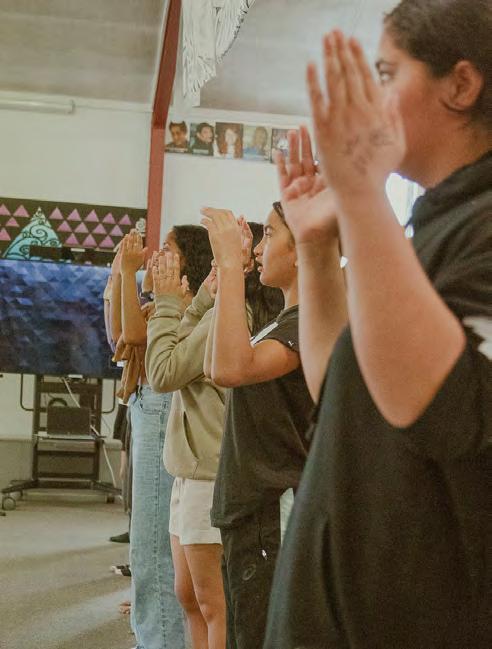




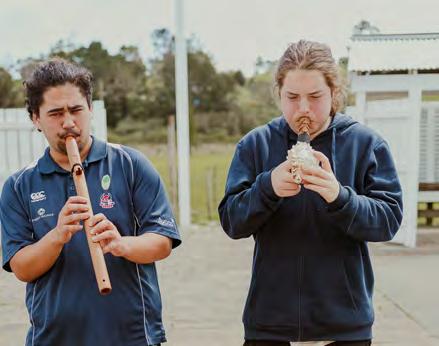
“Take care of our children. Take care of what they hear, take care of what they see, take care of what they feel
For how the children grow, so will be the shape of Aotearoa”DAME WHINA COOPER






The ASB Polyfest festival features traditional music, dance, costume and cultural speech competitions, and is one of the most recognised events on the Auckland calendar. It’s a showcase of New Zealand’s diverse cultures and a celebration of youth performance.


Students traditionally compete on six stages, performing traditional items from the following cultures – Cook Islands, Māori, Niue, Samoa, Tonga, and the Diversity stage featuring performances from a range of cultural groups including Fijian, Tokelauan, Chinese, Korean and Indian. This year was the first time the festival was able to go ahead with a live crowd since 2021 and it was exciting for students to be able to have a crowd watching them perform live. I have been lucky enough to have been a part of this event as a student, performing in 2002, to being heavily involved as a teacher for many years.
Term One is a busy one for Pasifika music teachers in Tamaki Makaurau as we are heavily involved in the cultural groups of our kura. Schools usually form their groups in the first week of term or for some schools, during the holidays. Most of the weekends leading up to the competition are spent rehearsing,

making uniforms, getting instruments and instrumentalists ready, and for some, composing traditional songs for their groups.
The competition this year was held earlier than previous years with schools getting five weeks to prepare. Each stage has its own theme that performers and leaders use as a basis for their overall performance whether it be through the actions of their dances or the lyrics in the songs they perform. On the day of the competition nervous students await their turn on stage, behind the scenes parents and family members are getting their child ready in their traditional cultural attire. Teachers are ensuring all drum sticks and instruments are ready for the 20-minute bracket they will present to the crowd. It was an enjoyable experience not only for the performers but also the spectators as they were definitely enjoying all that Polyfest has to offer.
Most of the performances from the festival can be accessed on the ASB Polyfest website.
At the end 2022, we were left without a dance teacher.
I was in my second term as Head of Learning Area in Performing and Visual Arts at Kaitaia College and faced a shortage of staff in our Arts Dept moving forward. Fast forward to the start of 2023 and I decide that I'm going to turn 2023 into the best year for dance at KC even without a proper dance teacher because we have lots of talented senior dancers, and I didn't want them to miss out on having a great year this year.
So I put up my hand to take Senior Dance and began an ambitious plan to take our Senior Performing Arts class to do their Sasā assessment for NCEA at Polyfest itself rather than just the boring old class assessment. Our kids deserve the best opportunities like any other dance students in the country.
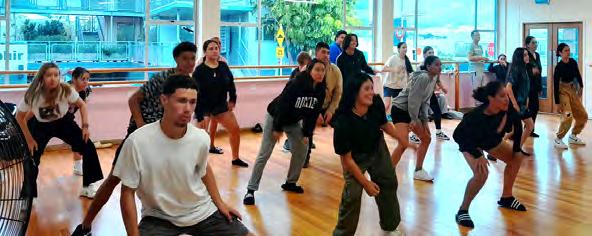

With only five weeks to rehearse, they started to practice and develop their own Sasā as I guided them through the process. Though they were unsure and nervous at the start, it was a thrill to watch their confidence grow over the 5 weeks as they started to own and began to believe and get excited about performing at Polyfest 2023. Finally the day came and we headed to Auckland on March 9th at 6.00am to try and beat the slow detours and road slips.
I was lucky enough to have friends in the dance profession who offered to take our students for some different dance experiences that included Ballet at Cameron Ballet studios with Chrissy, and Hip-Hop with Maddie at Viva Dance Studios Newton.
Those two activities did a lot of good helping our kids bond and gain some much-needed confidence for the Polyfest stage.
The day came and though it rained as they entered the Samoa stage, our students smiled and walked on stage confidently. They did themselves, our school and our small Far North community proud with their performance. The energy was fantastic and their smiles were beautiful.

There was a small section of their Sasā where we included the intro from our school haka - we did this because I wanted our predominantly Māori students to be proud of who they are, and to feel confident that they can carry themselves positively in any social context they go into, including Polyfest Samoan stage 2023. The buzz took several days to subside but they have come back to school with a new sense of confidence, feeling more courageous to tackle the challenges in front of them in dance at Kaitaia College for the next 10-12 months.

They are already looking at participating in a dance competition later this year, a Gala show of scenes from several musicals, and most exciting of all, a trip to LA in 2024 to visit some of the world's leading dance studios and experience for themselves a taste of what the dance world might have to offer.
All of this started with a group of kids from a small town, willing to give Polyfest a go, and see where the journey might lead...
Dr Opeloge Ah Sam Head of Performing/Visual Arts | Kaitaia College



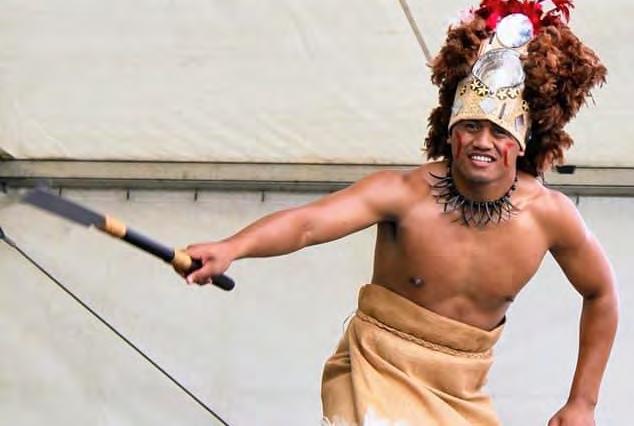




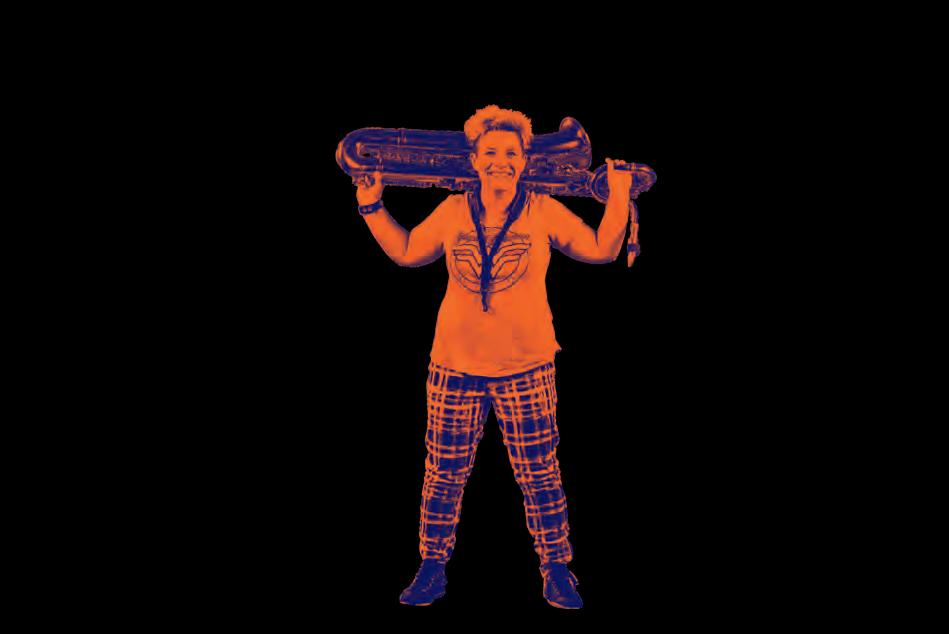
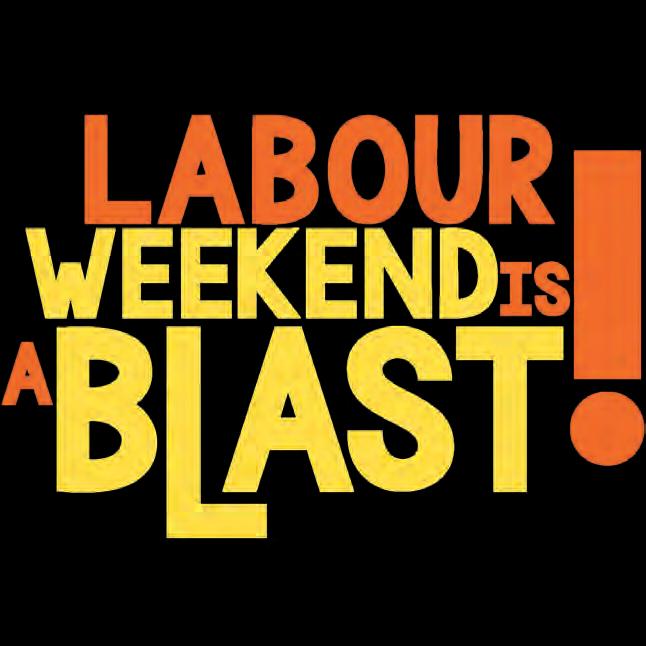

Have you ever been in a situation where you have an unlikely combination of instrumentalists at school? And they have all signed up to be in the school orchestra? Perhaps a beginner violin, an advanced recorder, a bassoon and a bagpiper? What do you do?

This is an important question and we'll look at some effective solutions, but first it helps to start by being clear about the objectives of the group. I’ll give our school orchestra as an example, which I ran from 1999 to 2021. Because we are an intermediate school (mainly 11 and 12 year olds), we start pretty much from scratch each year as year 8 students leave and new students gradually join throughout the year. One of our objectives is that the orchestra should be an all-comers group - some other groups at our school aren’t, and some all-comer groups just focus on one instrument (like marimba, ukulele or recorder) - but the orchestra is all instruments for all players. Another objective is that all players enjoy playing in the group. This means we want the group performance sound to be a good one that they are proud of, and that the level of music for each player is achievable with hopefully just the right amount of challenge in it.


If you’re new to taking instrumental groups, hopefully these tips based on my experiences can be of some help.
1. Get to know your players' capabilities. What is their note range, their tone and how do you expect their playing to be in a term’s time?
2. Choose music that really suits who you have. When we had a bassoon, we played In the "Hall of the Mountain King"; when we had a bagpiper we did "Amazing Grace", when we had a soprano singer we backed her for "Dream a Dream", when we had a virtuoso recorder player we did a Vivaldi concerto. For the concerto, the orchestra part was super easy, but everyone thought it was amazing because the focus was on the recorder player.
3. Students often come up with great ideas for repertoire. Get the students to list ideas that they can imagine sounding good with the instruments you have. We listen to excerpts if needed, then vote. Then I take the list away as a starting point, although not all suggestions might be used.
4. A quick “cheat”. Have you ever had senior staff ask you to provide a performance next week for visiting guests – and it’s only week 3 of term one? If you are wanting to be up and performing quickly, pick a particularly strong piece that a more advanced student can already play, and orchestrate your other players to “accompany” it.
5. Specialised groups. Sometimes it may be worth starting up an extra specialised small group that features an unusual instrument, such as an Irish group for your mandolin player (if you have someone who could play a tin whistle as well), or starting an interesting chamber group. We once had a lovely chamber group consisting of a boy soprano, baritone horn, flute, piano and double bass.
6. Occasional feature item. Some specialised instruments may only feature in one or two pieces that year, such as a soprano or a bagpiper.
7. Getting specialised arrangements. There are a few main ways to get specialised music:
1. Buy school orchestra music and adapt parts as necessary;
2. Arrange (and maybe transcribe) it completely yourself;
3. Ask a local high school or tertiary music department to suggest arranging students (who may be able to credit their work for studies);
4. Pay a professional to arrange for you.
You will need to make sure your school has their APRA licence before you do any of these.
If you are arranging the music yourself, yes, it does take a lot of time! This is a good reason to start the year with an easy piece, and a requested or popular piece used in the past, which only needs a few tweaks to work with the new line up. For new arrangements, it can be ok to give out “the draft version” on the first week of its playing, so long as it’s clearly labelled a draft and ceremoniously thrown out the following week. Although it might seem to be a waste of paper, at least it gets the students a week ahead on perhaps that tricky rhythm or phrase which they can now proudly start practising, and they can anticipate the full version!
8. Overall tips for your group to sound good!
The following are some key elements to consider.
1. Balance: Can you hear the melody? If not, can you make the accompaniment softer by changing the dynamics or cutting out more instruments for a section, or do you need to add another instrument to the melody line? Are all the instruments high? Maybe you need to add a piano or some kind of bass part to provide solid support?
2. Tuning. Good tuning is perhaps the biggest factor in taking the performance to the next level. This includes tuning beforehand as well as helping students be aware of particular problem notes. In some cases student instruments may need upgrading if they have serious intonation problems!
3. Correct notes. Always be on the listen out for off notes. Students (and the surrounding students) are grateful to have a misplaced note pointed out and corrected rather than hearing it wrong over and over (which can either be soul destroying to the student who is hearing the error, or it can lower the expectations of the whole group). They will also respect your good hearing if you notice! I usually let a bad note go once or twice to allow for student self-correction, but always correct it by the third time. Off-notes could be a misprint in the music, a wrong fingering, a problem with the instrument (e.g., stuck pad or valve) … it’s amazing how many things can go wrong. Like that time the tin whistle got stuck in the bell of a trumpet….
4. Good rhythm. Make sure students are familiar with the rhythm, particularly for things like syncopated or swung rhythms. You can model the rhythms to them, have them clap or sing them, and play clips of the piece being played professionally. It helps to maintain good rhythm in the ensemble if you can confidently conduct, and look at students while clearly bringing them into an entry after they have had a few rests!
5. A Good Arrangement. For example, have good harmony with well-spaced voicing, thoughtful texture and balance, good use of the character of the instruments, and interesting, achievable parts for the players.
When you break it down to the five bullet points, it doesn’t sound like it takes much to make a successful performance piece. I keep reminding myself and the students of these achievable goals!
9. Using instruments.
Strings: We never have many strings, and there will be a range from good players to absolute beginners. For beginners, I mainly write using open strings and first position notes. The string section can be boosted by a keyboard set to a string sound, or pizzicato strings sound. If played alongside real strings, the sound can blend quite well.
Keyboards: We can include several keyboard players, but they all play different roles, such as boosting the strings, playing a cinematic choir sound, playing a glockenspiel instead, adding a harp part, or covering an oomphy bass line if needed.
Clarinets: These are lovely for inner parts. If they are beginners, keep them in the low register (below concert A).
I often don’t have a French horn, but I love the idea of typical French horn lines. These have often ended up being transferred to instruments like clarinet, saxophone, tenor horn, or trombone.
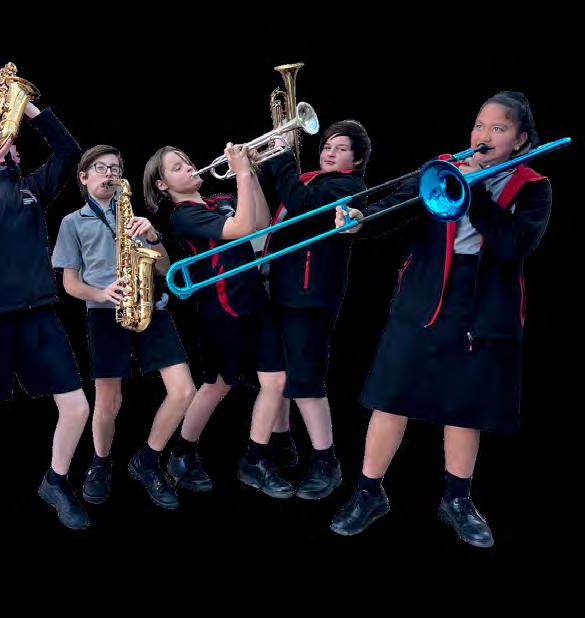
Trumpets and saxophones: Trumpets are loud, and it’s ok to not have them play all the time, otherwise you might not get a good texture, timbre and dynamic contrast! We usually have one piece in which trumpets are really essential, and one where they are saved just for the climax of the piece.
Bass lines and lower parts are important for balance. Timpani (or electric drums used as timpani) can help with this because one player can generate a solid lower sound to balance an often disproportionate number of treble instruments! Timpani is also useful because of the climatic hits or rolling tension it can provide. We allow electric bass (not too loud) in the orchestra and this can be useful. Make sure your bass clef instruments aren’t clustered in close low chords (unless you want a thick muddy sound). They should be more like a fifth apart rather than in 3rds if below the D line. If you think of how a harmonic series is spaced, this is a good guide for frequency spread when arranging.
Untuned percussion is a useful way to increase the vibrancy of many scores as well as involve more students. A crescendo suspended cymbal roll can achieve a very effective build-up for the ensemble and a bass drum is effective at many dynamics, and there always seems to be a student cut out for this role!
Adventurous instruments. Once we had an orchestra piece that featured an iPad instrument (lead synth in the theme from Dr Who) and an iPhone recording of the Tardis through a small PA. These were set to flight mode of course to ensure we got no calls or notifications during performance! Interesting percussion instruments (not over -done) can also add colour to the piece and special roles for some students.
10. Counter melodies. These have a different rhythm than the melody. They often come in a beat or so later and “fill” in gaps with new melodies. This is a handy device for adding colour and musical meaning (the counter melody could be poignant or jovial), and gives a featured part to another orchestra member.
11. Know your instruments. The more you know about your group’s instruments the better. For example, for younger groups, it saves a lot of time if you know fingerings, including alternative fingerings. What
trills and tremolos are easy or too hard? At times, I’ve kept a fingering chart in the back of the roll book for emergencies. For advancing groups, what special characteristics and techniques do your instruments have? For example, consider different sounds in different registers, pizzicato, mutes, tremolos, harmonics, etc.
12. Physical placement of instruments. Sometimes it’s helpful to alter the traditional layout so that soft instruments can be heard. For example, I often have to put our low register clarinets with not-to-bemissed lines near the front of the orchestra. If an instrument is playing a similar part to another, it may be helpful to seat them together.
13. Choosing the key. Beginner wind, brass and strings will never be ideal together with regard to key choice, and some argue it shouldn’t be attempted. But if we are going to, then some solutions are to favour the brass/clarinet/sax if it’s a “brassy” piece and let the advanced strings have challenges, but find harmony notes in the beginner string parts that stick to open and first position as much as possible, or favour a string key and choose easy notes for brass, or be prepared to teach the fingering for new sharp notes.
14. Practice and listening. If possible have a demonstration recording for students to listen to and practise along with, as that can be very helpful. These could be collected on a Website, Google Site, Wakelet.com, Canva, Google Classroom or whatever your school uses, so students can hopefully access it from home.
15. Production Orchestra. When we have our bi-annual production, the orchestra is made completely of our student orchestra. They have to learn around 16 charts for a production with a wide range of styles from accompanying a soloist, chorus or dance, to playing an overture, scene changes (looped until the set is in place), and producing atmospheric and mood music. I always find the ability and growth of the group at that time is massive, and it’s great seeing how much fun they have in the process of learning through hands -on experience. But it does take a mountain of preparation.
16. Composition. If you compose or arrange, it can be inspiring for students to play a “home grown” piece you have produced for them to play. And it’s very exciting when a student composes a short original piece for your orchestra! It has happened at our intermediate, but it is rare. The important thing is to be open to it happening.
Musical Examples Here are some examples of unusual repertoire that we have ended up playing:
•Vivaldi recorder Concerto with a virtuoso recorder player
•Bréval Cello Sonata and Clementi Piano Sonata
•The Final Countdown with a strong trumpet and good guitarist
•Dream a Dream/Danny Boy featuring vocal soloists
•In the Hall of the Mountain King with bassoon
•Dance of the toy flutes (Tchaikovsky), and The Aquarium (Saint-Saëns) when we have had 3 advanced flute players
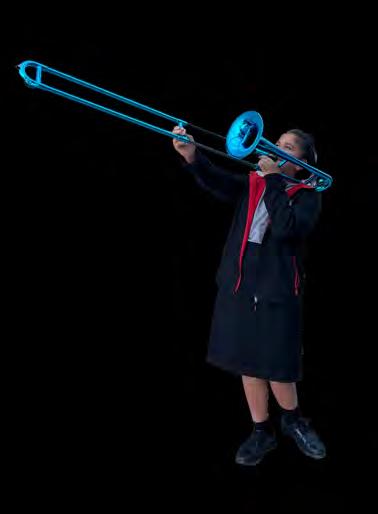
•Amazing Grace when we had bagpipes (orchestra entered on the second time around)
•Trumpet Tune (Clarke) when we have strong trumpets (also useful at the end of the year for processional during prize giving)
•The Pink Panther with clarinets and saxes who have mastered the tune and like to wander out the front playing by memory.
•Doctor Who using iLogPro synth on iPad to play the famous melody and tardis sound off a phone (in flight mode).
•Soundscape music to accompany an ethereal scene in production. All students play Taonga Pūoro or keyboard sustained notes or iPad effects.
•Star Wars has good contrast of brass intro and theme with gentle (flute/violin) middle section
•If we were wanting to feature marimbas then Latin tunes (with diatonic melodies) work well, as do Tijuana Brass compositions, and quite a bit of gaming music has worked well with marimbas. One movie theme that students requested had a Celtic feel, so we combined with the school Irish band for that piece.
•A couple of pieces that keep getting requested, which I only have to adapt a little each time because of different players, are Pirates of the Caribbean (we now have 4 pieces, which make a suite!), Mission Impossible and Star Wars.
•The National Anthem can be played with a full palette of colour including taonga pūoro and/or flute introduction, adding congas, guitars (including electric) and full orchestra.
• Conquest of Paradise with choir (and/or a choir sound on keyboard) has been useful in Canterbury when big rugby matches are on or when local pride needs boosting (for example after the earthquakes).
• Our school song “We are Chisnallwood” is orchestrated and played annually.

Finally... A number of regions have local professional orchestras who offer good deals to school groups attending their concerts or rehearsals, and these can be inspiring for students. Also some regions have orchestra festivals where you may be able to have your group play and even have a workshop.
Whether we are running a young school “orchestra” or any kind of instrumental ensemble, many of us face similar challenges. Our goals include teaching orchestral principles that include appreciation of the different instruments and genres, commitment to rehearsals and practice, performance etiquette, exposure to old, new and diverse repertoire, and supporting a life-long journey of involvement, friendships, and enjoyment of music.
BIO: Judith | LAIRMT, MusB(hons) was the music director at Chisnallwood Intermediate for 23 years which included running multiple performance groups, music technology and theory. She currently runs the jazz programme at Chisnallwood Intermediate and directs two Shirley Boys High School Big Bands. She is co-chair of Music Education Canterbury, co-music director of “Strum Strike and Blow”, and chair of the Christchurch Jazz Foundation Trust that oversees the Christchurch Big Band Festival. She is a member of the All Girl Big Band and Sideline Swing. She has recently composed the Kiwicorder resource and become a grandmother.
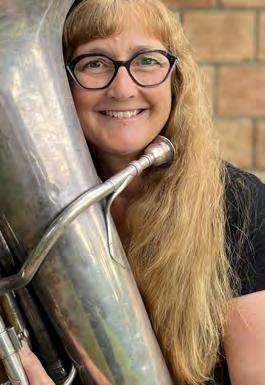 JUDITH BELL
JUDITH BELL
Often you hear about students having different tools in their kit or skills to cope with different situations, but I first heard this phrase at the Kodály Course in Christchurch this summer. I was excited to hear how we can develop a student's musical mind to help them learn an instrument well and understand that music opens a world of active listening, hopefully for a lifetime. In January, my school provided an opportunity to attend the Christchurch Summer School Programme and complete Level One of the Kodály Certificate (secondary) over two intense weeks.
From the student's perspective it means clapping games, singing, and moving. For some, singing is entirely new to them, but I am observing some of these students finding their voice.
By tapping into a student's underlying musicality, I can show them how music is logical and fascinating - something I hope to develop with my students further this year.
Clearly, I am quite excited by what I have learned. At a recent social event, I talked so much about how this course has transformed my teaching. I sat with a group of non-musicians and shared what I had learned, with one friend commenting, "Oh, that was your do, re, mi course…." Yes, but so much more! I spent the next 10 minutes telling this group of people (remember it was a social event!) about the clear pedagogy of preparing students, setting them up for a new concept, and then reinforcing this concept, often through games and practice so that each student is the one contributing to their learning.
As a secondary school teacher, I see this process being used from Years 7 to 13 - taking a concept, preparing students well, allowing them to discover the concept aurally and visually, and then reinforcing this all through active listening to music.
And underlying all this structure was a student-focussed pedagogy. I particularly loved delving into educational theory, but I also recognised how perfect this opportunity is to practically work it out with the students in front of me.
The two-week course was busy, with homework each weeknight and a major assignment on the weekend. In particular, the three practicums were a challenge. Being publicly critiqued in front of peers had many benefits and clarified my language and delivery style. Even now, as I reflect on what I taught today, I can think back to the moment when my students became excited by seeing the clarity of time signatures as we sang songs and clapped. They understood the concept of rhythm and metre, all within the space of three minutes.
So, what did I get out of this course? A little about me: I am a music teacher at Baradene College of the Sacred Heart in Auckland, where students have a wonderful opportunity to learn an instrument for two years, starting in Year 7. As part of the Baradene Year 7 and 8 Music Programme, students can choose between violin, cello, flute, saxophone, clarinet, trumpet, and trombone. Itinerant teachers provide 25-minute group lessons, and students also work with me for 25 minutes each week, learning the skills of a musical mind and musicianship.
Some more of my key takeaways from this course are:
•A high expectation that all students can learn through play and singing.
•It supports the itinerant music teachers being able to focus on students learning their particular instrument.
•Preparation of lessons is vital to developing and implementing what I have learnt – I look forward to seeing all that planning in action with the students.
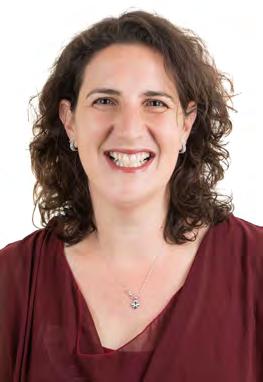
If you have the opportunity to attend this course or are thinking about it, make the time. Training a generation of children in this way could have a significant impact on students’ learning in all subjects. It has refreshed my understanding of good teaching practices, and I am excited to see my students flourish musically this year.
BIO: Rachel completed her Bachelor of Music in Performance at Auckland University with Tamas Vesmas. Looking for a sense of adventure, she went to Hungary to do post-graduate study in performance piano at the Franz Liszt Academy of Music, Budapest. She then trained as a secondary teacher, while continuing to teach piano. Rachel then went to teach at St Mary's College in Ponsonby, teaching music and conducting choirs. After being at home with her three children she has been involved with the music departments at Epsom Girls and Diocesan. Rachel now teaches at Baradene College and directs the choirs at both Baradene and St Peter’s College. She enjoys singing with Voices NZ and Viva Voce.
" The depth of pedagogy shown in this course was extraordinary. The clarity and simplicity of the structure, teaching all students to understand complex musical forms, was mind-blowing, focussing on inner hearing combined with singing and clapping in canon."

Doug went from being a trumpeter and arranger for the Royal NZ Air Force during World War II to a principal arranger and director of the Doug Kelly Radio Big Band for over 40 years. His school teaching after the war grew into being District Advisor to the Canterbury Education Board for 20 years including helping organise the 1985 local ISME (now MENZA) conference in Christchurch.
He inaugurated the Christchurch Schools’ Music Festival’s representative orchestra, special instrumental groups and choirs (along with the special groups’ holiday programme) and orchestrated many massed items for them for almost 30 years. He also conducted and founded the brass classes at the Christchurch School of Instrumental Music, and arranged the music for the huge, massed performance celebrations.
He played trumpet in the Risingholme orchestra until well into his 90’s and enjoyed practising even during lockdown, and was still composing for Big Band at age 95. Doug was an enthusiastic supporter of jazz performances and an enthusiastic adopter of technology throughout his life. His encouragement, involvement and wisdom did much for the jazz scene in Christchurch over the years including advising when the Jazz School was set up.
We are forever grateful for the legacy Doug left that includes working to initiate and develop instrumental music education and performance, bringing accessibility and opportunity for orchestral, jazz and contemporary styles in both education and performance, and left a wealth of ensemble arrangements. We are grateful to have known such a much-loved, witty, dedicated, musical, encouraging, quietly influential and inspirational person.







With its awarding winning design, multi-dimensional sound source and unique technologies, the Privia series has re-imagined the standard for digital pianos. Compact & portable, The Privia PX-S1100/ PX-S3100/ PX-S5000 have been developed with musical expression in mind, their modern compact designs are crafted to match a range of room sizes and interiors without compromising on the qualities you would expect in a musical instrument.




The CASIO MUSIC SPACE app is exclusively for Casio digital piano and keyboard users. When connected to your Casio piano or keyboard, it serves as a digital musical score viewer designed specifically with Casio products in mind. The app includes lesson functions, live performance simulator, piano remote control and much more!


